Post by ferrari512s on Jan 7, 2014 15:09:24 GMT -5
Ultimate Hot Wheels Cars|Channel C00236562
Car Craft Dream Rod / Tiger Shark / Cheetah / Python
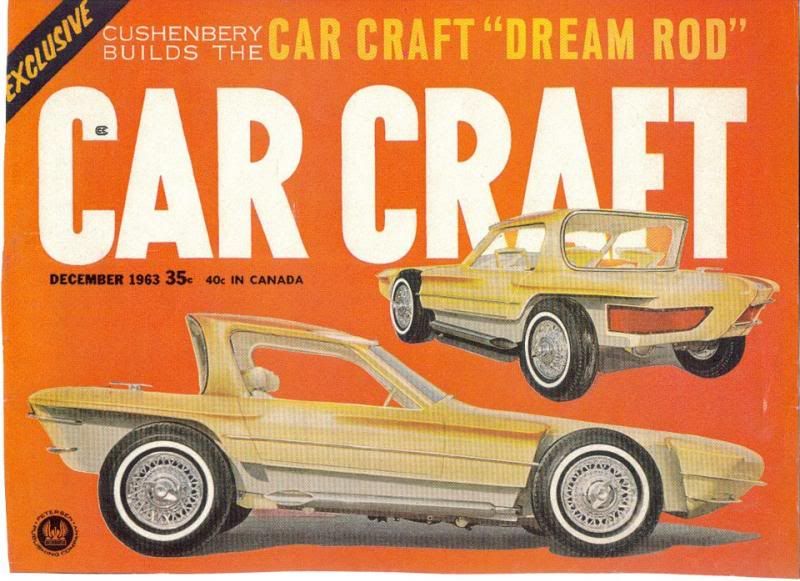
The Car Craft Dream Rod was built by the famed customizer, Bill Cushenbery, for Car Craft magazine which carried a full feature on the finished car.
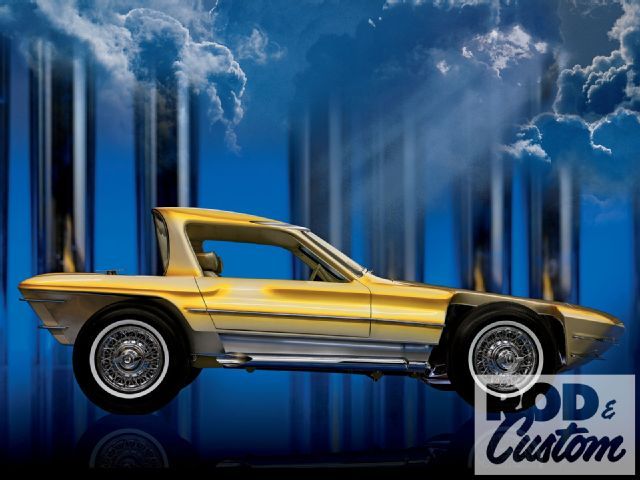
Built from a wide array of parts (including several body panels from a 1960 Pontiac and a 1961 Corvair!), the fogged candy/pearl white/yellow custom was powered by a Ford 289 and was a wild hit on the custom car show circuit.

It was popular enough that MPC issued a faithful 1/25 scale kit of the car.
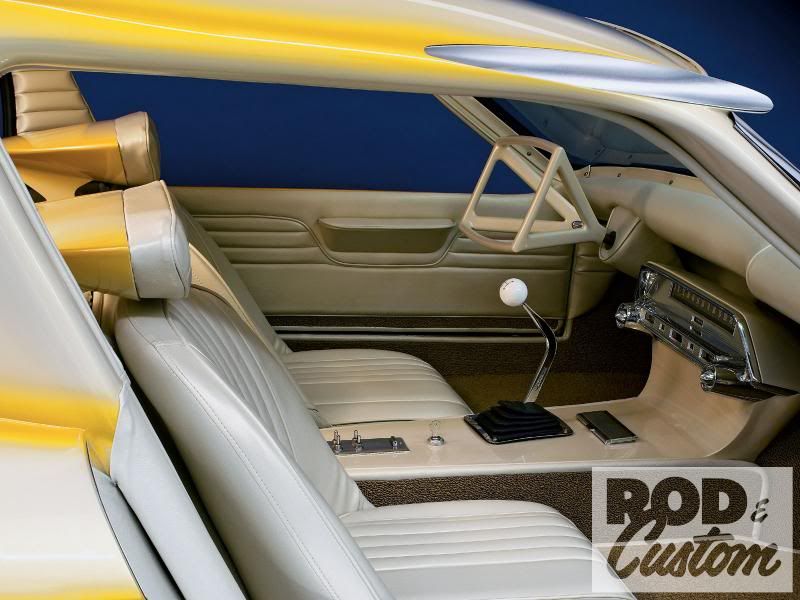
A few years after it was built, it was sold to the ISCA which commissioned a substantial revision to the car's styling.
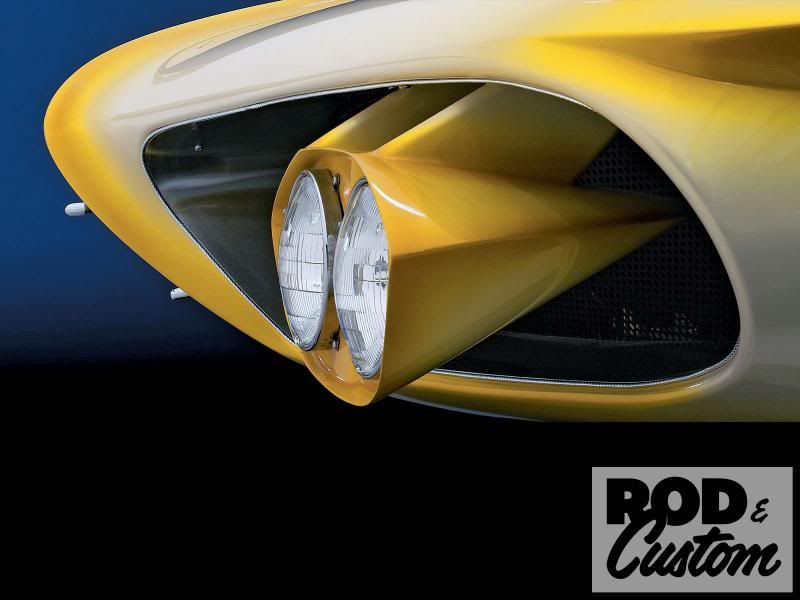
Called the Tiger Shark, the car wasn't as successful as the first iteration, the car made the show car circuit and was the subject of a revised MPC kit.
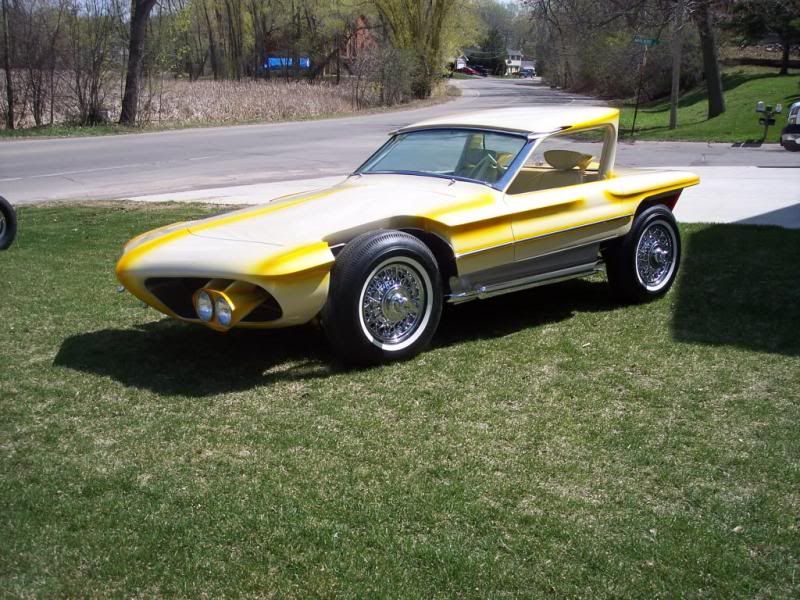
Now, the car has been acquired by a new owner who is restoring the car to its original configuration.
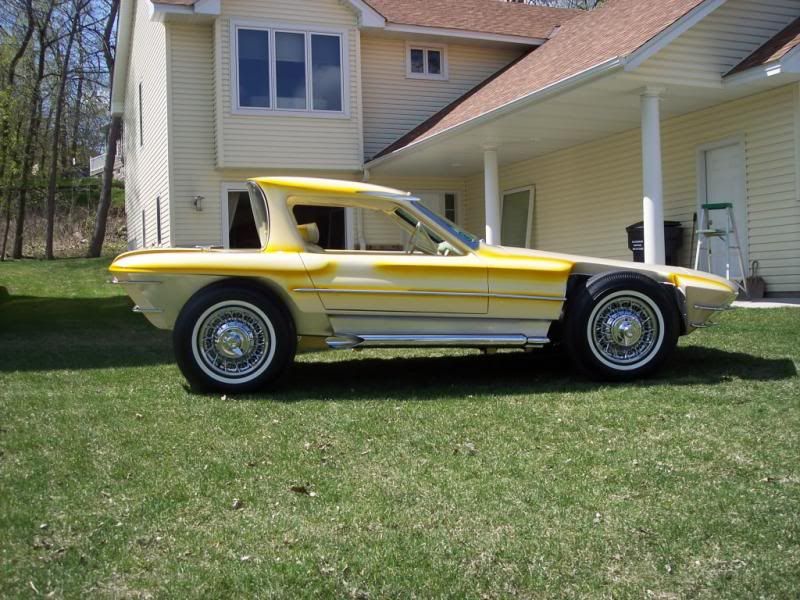
Thanks to Dick "Fuzzy" Fuerholzer for the restoration photos presented here, and thanks to famed custom car restorer Mark Moriarity for the photos of the Tiger Shark before he started the retro-restoration of the Dream Rod.
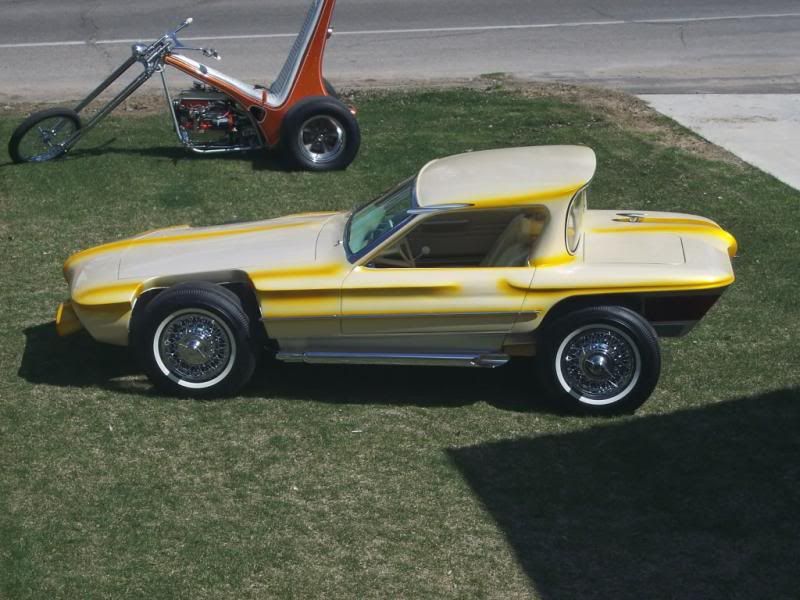
Car Craft Dream Rod / Tiger Shark.
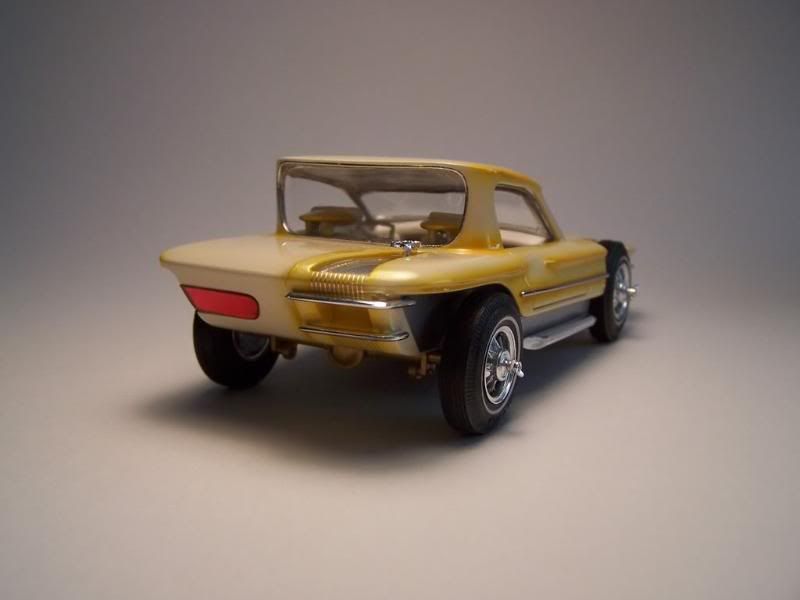
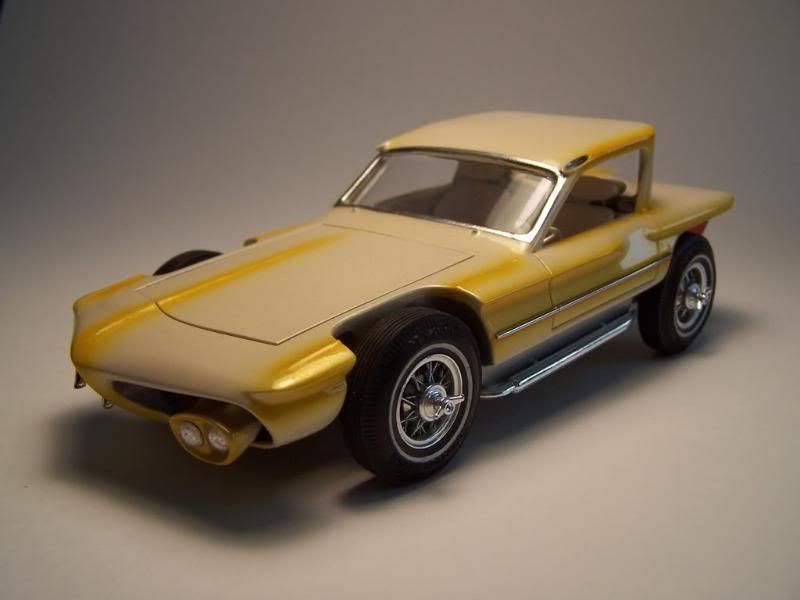
The interior of the Dream Rod. What an interesting design for the steering wheel.
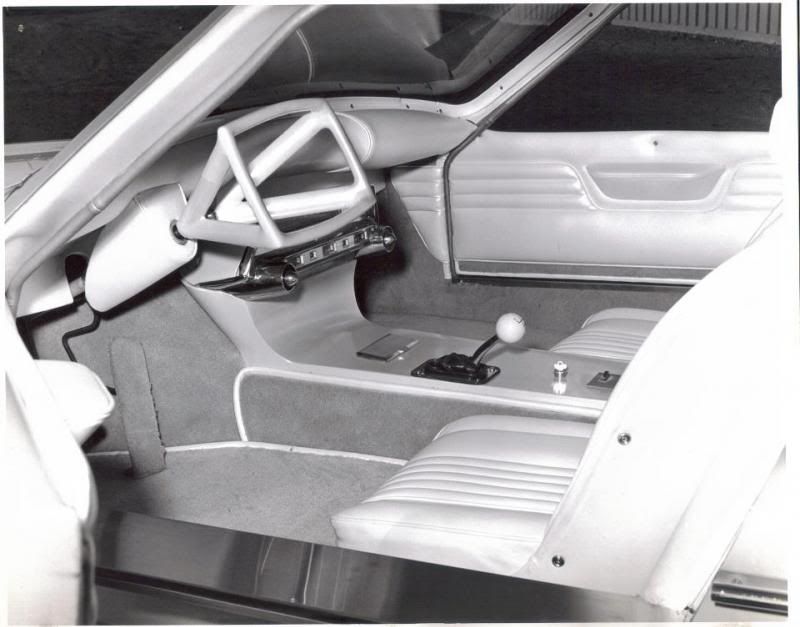
A rear view angle of this concept show car.
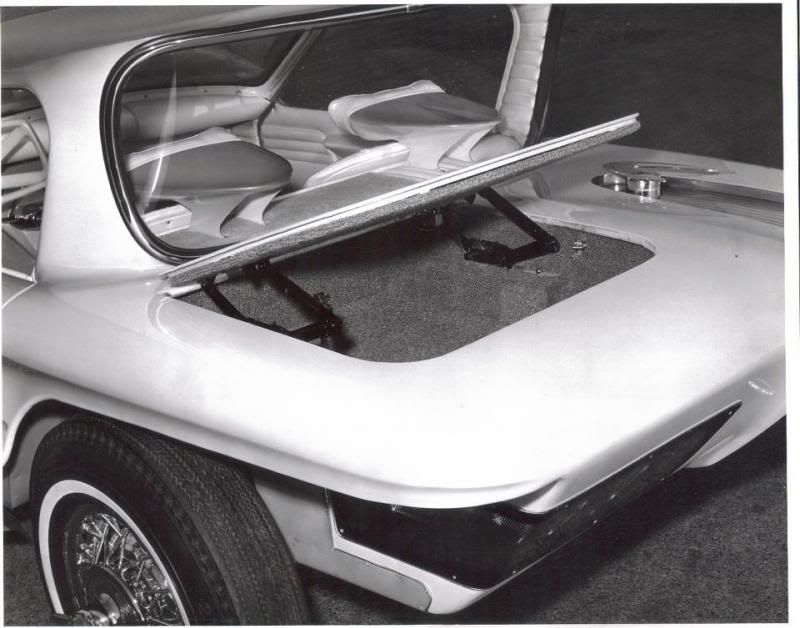
Quite a bizarre front view angle showing the headlight.
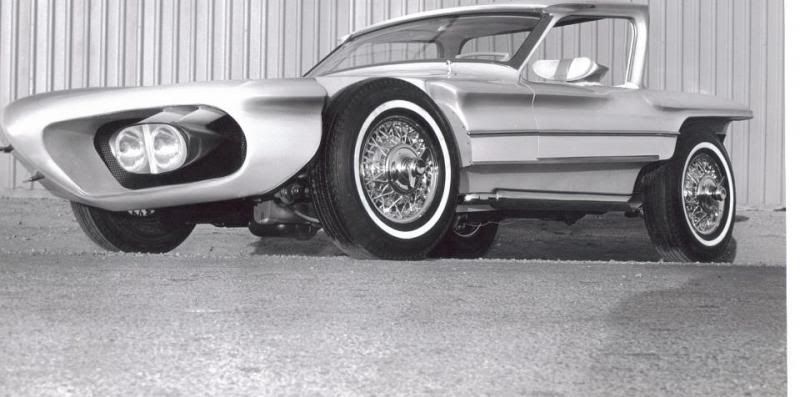
The engine under the hood.
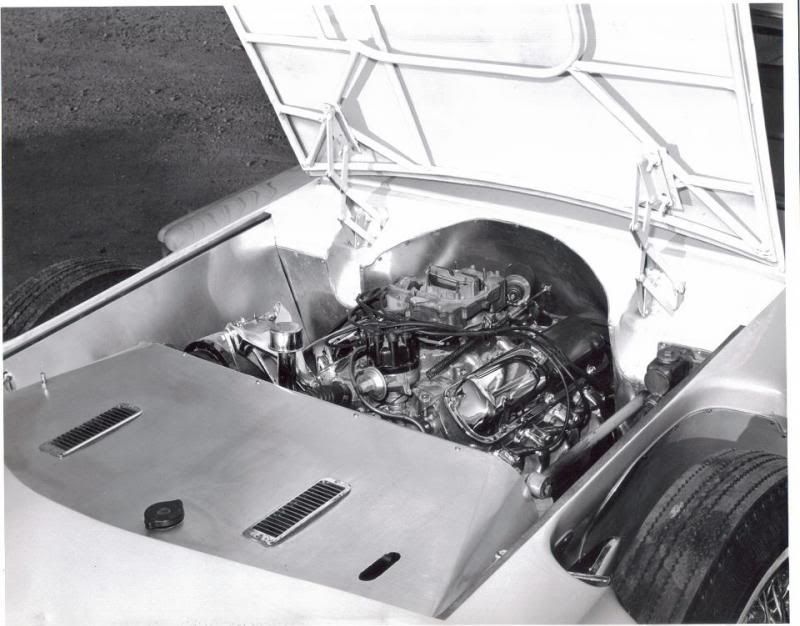

Check out the narrow white wheel spoke tires!
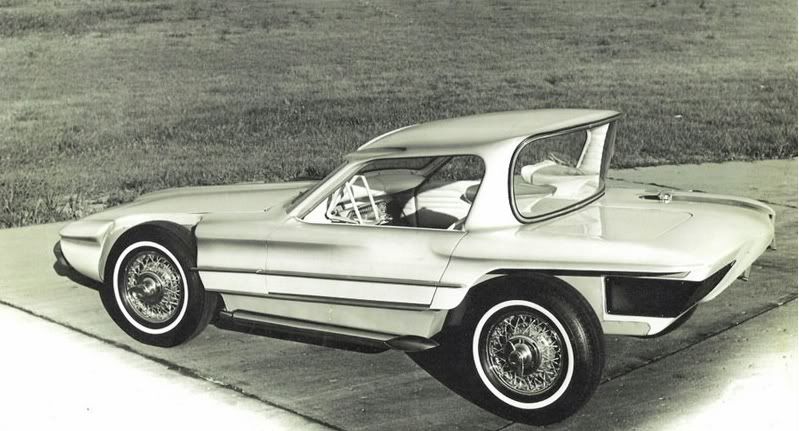
The built model kit with the Hot Wheels 1:64 scale car beside it.
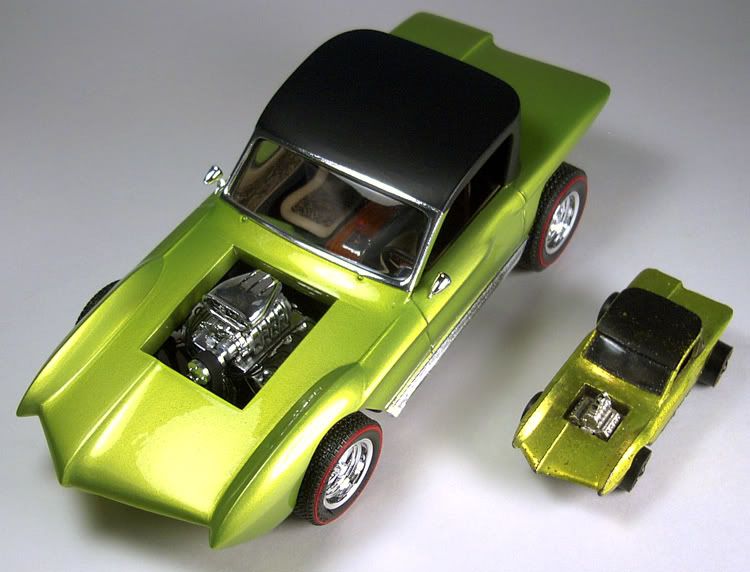
I must admit this model kit really looks sweet!
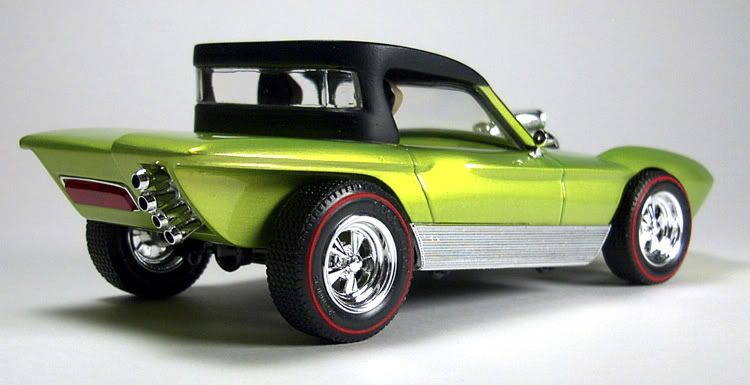
This model kit also looks amazing with thos redline Good Year slicks!
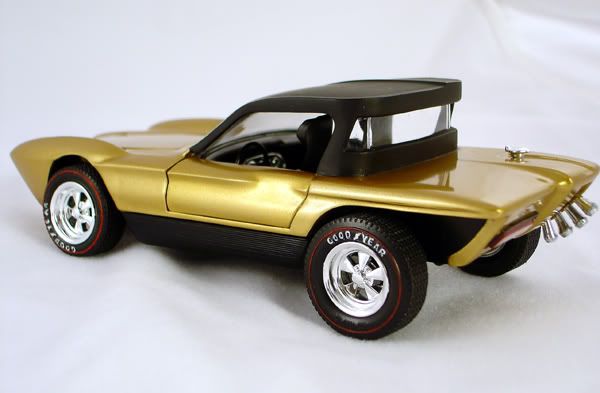
Details and images courtesy of...
www.customclinic.com/fullcust/Cushenbery/ccdr/ccdr.html
The article...
I was able to locate the original article as presented in Car Craft magazine. Check out the scanned images below.
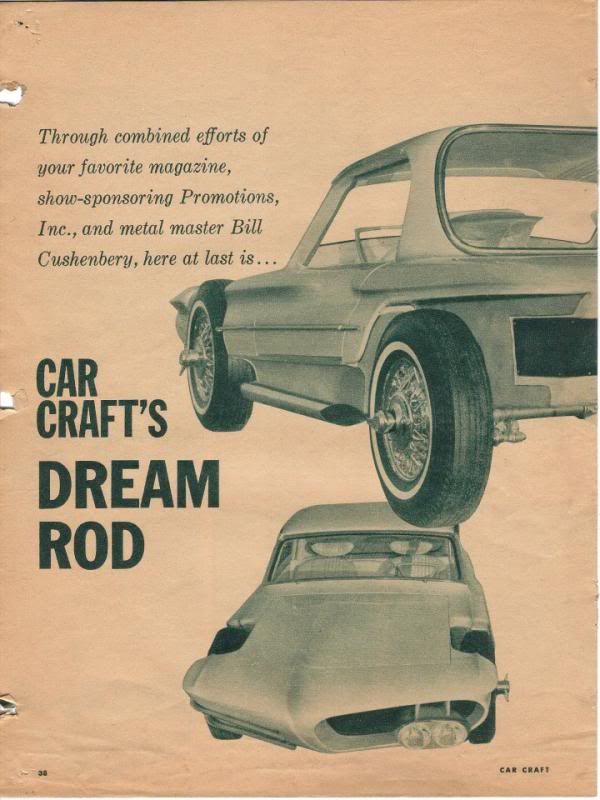
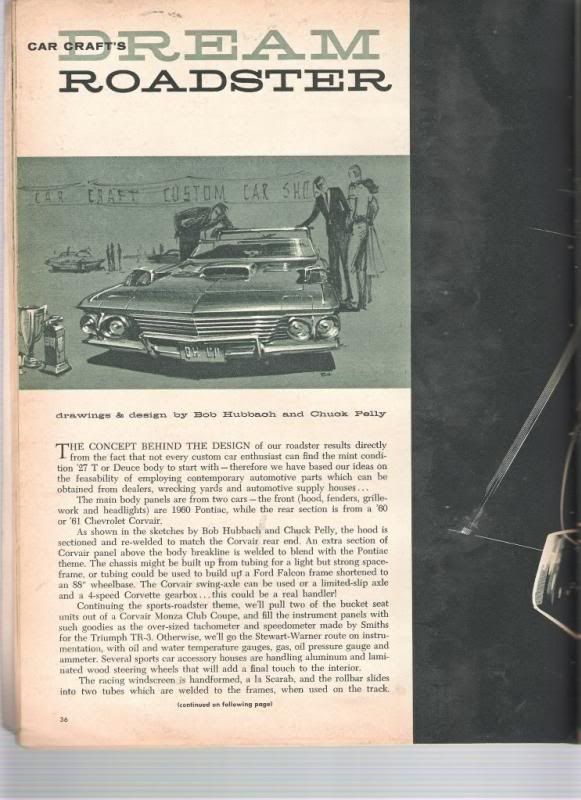

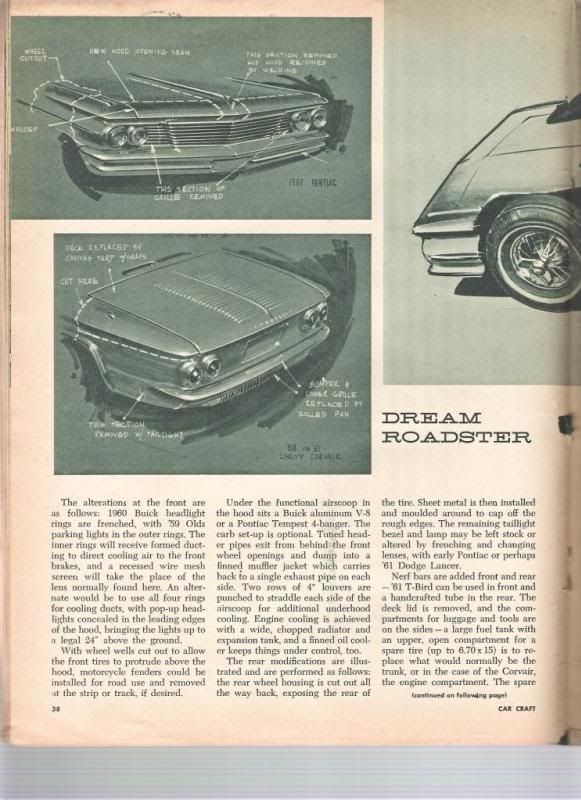

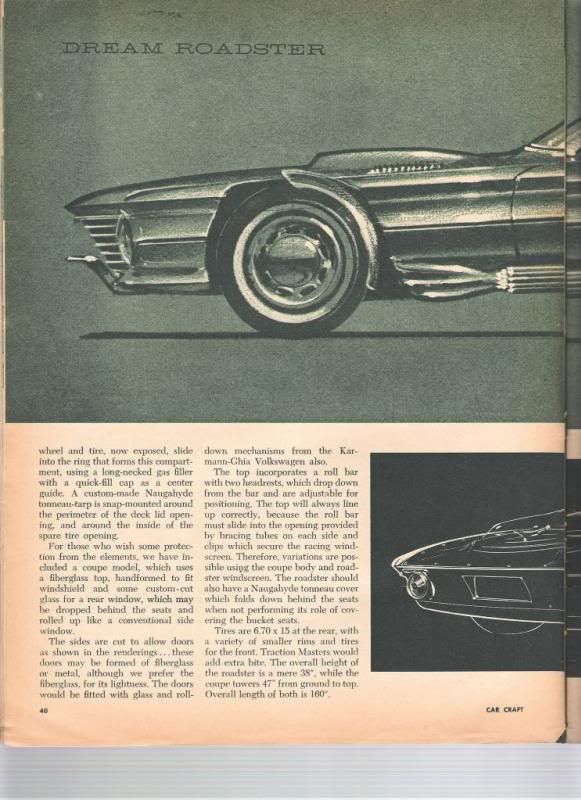
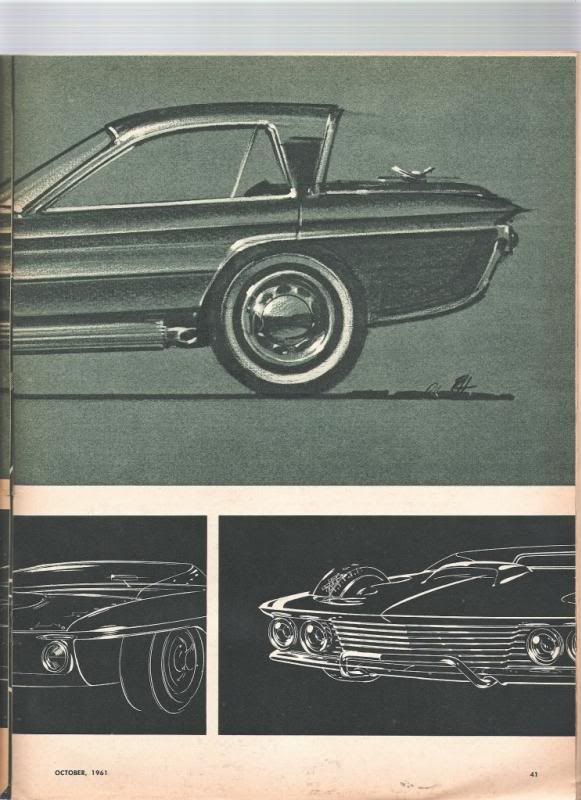
More on the Car Craft Show car is presented below in this article...
Hot Wheels Python® / Cheetah™
Python® / Cheetah™ Redline Era Historical Reference Synopsis - Part I
Preface
The Python® is one of the original 16 Hot Wheels die-cast models Mattel deliberated on and eventually with Harry Brandley's persuasion released in the spring of 1968*. This dissertation will focus on the chronological aspects of the Python® and reflect on each and every change that occurred from its inception.
*Take note, the date May 7th, 1968 is the official date derived when the subject matter was investigated and researched, "When were Hot Wheels® released to retailers". Furthermore this is mentioned, documented and discussed in several Mattel publications.
This Python® die-cast model actually began its' existence at Mattel as the Hot Wheels® "Cheetah™"! However, this name regrettably was not intended to be and was on no account officially released to the general public. **Nevertheless, there is one diminutive exception to this decree! There were a few prototypes which managed to escape the destruction process from both production facilities and hence the historical artifacts exist to this day. These Cheetahs™ are considered extremely rare and desirable to collect.

Image is courtesy of Bruce Pascal
**So what is the one Cheetah™ exception you ask? Well, I'm sure you will find this hard to believe but it is indeed factually stated in Bruce Pascal?s reference book, "Hot Wheels Prototypes" on page 84.
There exists a red Cheetah™ prototype in which Bruce Pascal acquired with plenty of edge wear as shown in the example above. This was initially acquired by someone who sent away for a cereal company endorsement in 1968. Mattel was engaging in these types of mail in promotions frequently in an effort to sponsor their toy lines. In this particular case, the Hot Wheels® promotion Mattel was sponsoring somehow provided the customer with this mint prototype red Cheetah™? Hot Wheels® car! What an unbelievable choice toy car this came to be! Obviously the Cheetah™ was well loved judging by the edge wear it acquired through the years. By the way, this is the only Cheetah™ to date adorning the beloved long tail pipes. Talk about extremely rare and unique! These attributes make this Cheetah™ artifact even more desirable!
Now back to our historical perspective...
The Introduction
The Hot Wheels® model known as Python® was produced in both the US and the Hong Kong plant facilities and was in full production until 1971. The Python® die-cast model has quite a remarkable history and it shall present it in this overview along with many other interesting particulars and facts.
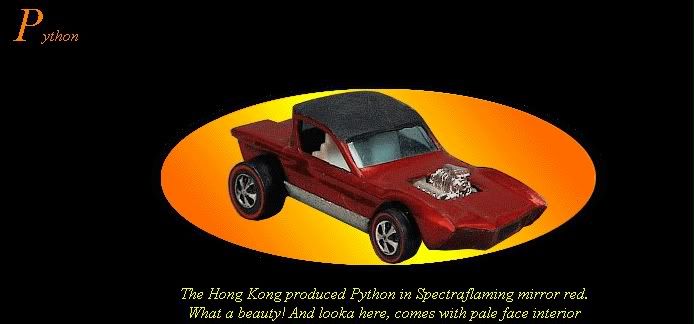
Image is courtesy of Ferrari512s
Let me formally introduce this model by providing some epigrammatic background specifications on the "Dream Rod" and closely followed by the "Tiger Shark".
Someone from the audience retorts, "I thought we were discussing the Cheetah™"?
Well, no need to be overly concerned, this will be an uninterrupted transition from the Dream Rod followed by the Tiger Shark and then the Cheetah™ returns along with the final retail product know as the Python®! It is just a brief segue spanning a mere 50 years.
The Car Craft Dream Rod
"The Car Craft Dream Rod was designed by the staff of Car Craft Magazine in 1961. The first drawings of the car appeared in Car Craft October 1961. In 1963 Bob Larivee of Promotions Inc with the approval and help of Car Craft Magazine commissioned Bill Cushenbery to build the Dream Rod.
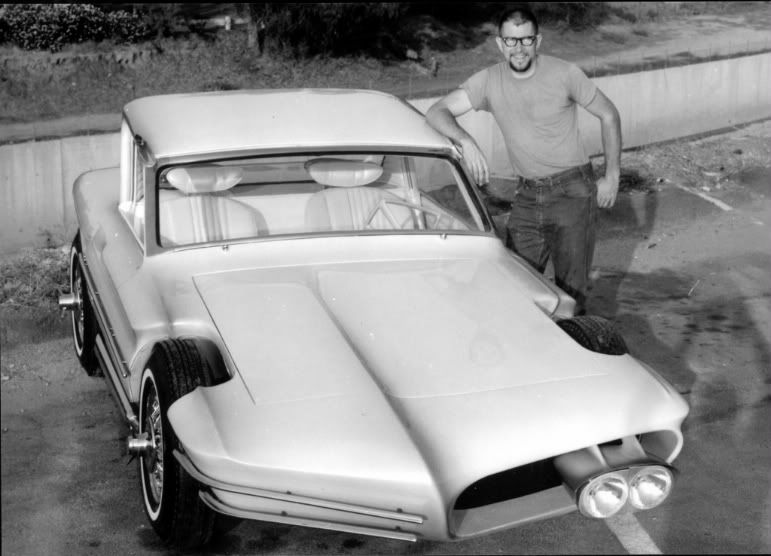
Bill approached Cushenbery to build the car after he had seen the Silhouette at the 1963 Grand National Roadster Show.[2] The car was completely custom made using some production car pieces.
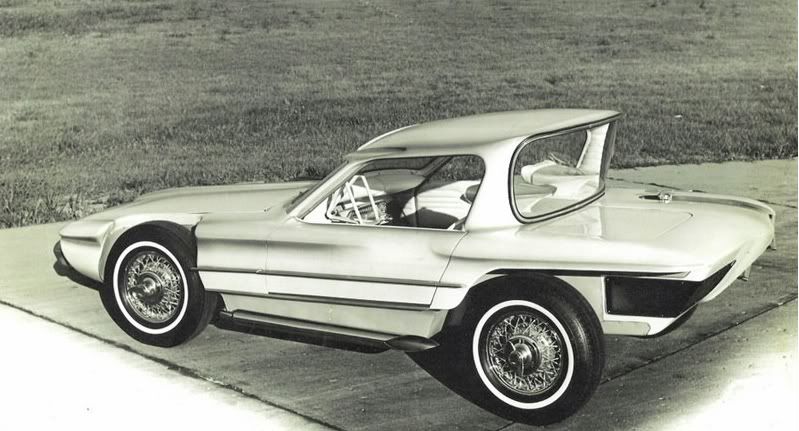
Bill built the car on a 1952 Jowett Jupiter chassis using a VW torsion bar in front. The frame was originally done in gold metalflake.
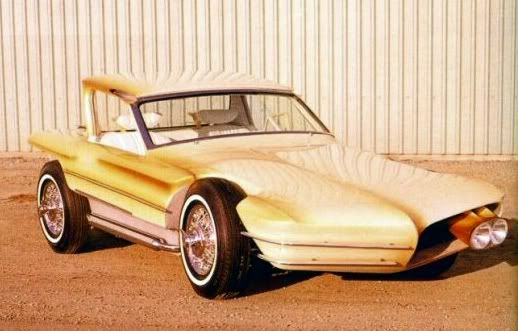
The front fenders and doors were taken from a 1960 Pontiac, upper rear quarter tops are from a 1960 Chevrolet Corvair, the windshield and top are from a 1953 Studebaker, and the rear window is a rear window from a 1957 Borgward Isabella Sedan turned upside down. Inside, the car featured a 1958 Mercury dashboard restyled with a 1959 Lincoln ashtray. The car got its power from a 289 Ford engine. The Dream Rod was completed late in 1963, and went on from Bill's shop to tour the custom car scene."
This information is courtesy of kustomrama.com
The Tiger Shark
Now, what's a Tiger Shark? Yes indeed, this was one of the more interesting and peculiar names prearranged for this somewhat intriguing and distinctive automotive design. By the way, there were some others quality names too and I'll expand on these later! But despondently or perhaps fortunately, (depending on your preference of choice) the Tiger Shark title didn't quite work out...for very long as was planned.
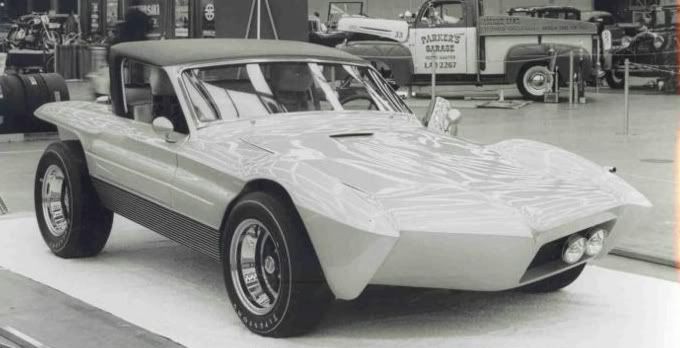
This image is courtesy of kustomrama.com
So after a couple of years, some remodeling by Harry Bradley and crew they devised something bold and innovative. Hmmm, now what should we call this breathtaking creation of ours? Well, how about a tasty little dish entitled the "Cheetah™"? We just adore this name and it appears so perfect for the model as well! And so the story goes, legends were told, myths were created, tribute concerts planned, theme songs were sung and statues erected? (all that fanfare) that, others loved it too... yes, not only Harry "Bently" Brandly, first Hot Wheels® designer, but even of all people, Elliott Handler, owner and head of operations at Mattel.
So Mattel decided to call tool number 6216 or the 12th model number chosen in Hot Wheels® history as the Cheetah™! However (well you sort of knew this was coming again), due to some pesky little licensing and patent issue, (these always come up for some uncanny reason), that Cheetah™ naming convention didn't last very long either. Such as shame indeed! Nonetheless, some USA made and Hong Kong Cheetah™ models, (F.E.P. that is) just happened to slip out of the Mattel die-cast production facilities with this name printed on the chassis. The question remains how many Cheetah™ prototypes were actually produced? The answer to this day remains a mystery but we tend to have a general idea after 45 years or so, very few indeed.
Take note the name "Cheetah™" with the "Trademark" symbol is listed on the base of the Hong Kong made versions, in various Hot Wheels® catalogs,blister packs, advertisements, shipping boxes and on other assorted Hot Wheels® products although Mattel never officially issued a Hot Wheels® Cheetah™ for retail. Now how is that even possible if Mattel didn't own the Cheetah™ trademark? Anyone care to speculate on this peculiar event?
The only two discovered USA made versions doesn't have the Cheetah™ trademark on the base. A very interesting development...and it makes me wonder.
Did the US plant know something about the trademark issue and didn't mention this slight concern to the Hong Kong plant?
Was the Hong Kong production facility in competition with the US plant as to who could make the mold and complete the Cheetah first?
Could this be why we have so many differences from the US produced and Hong Kong made cars?
These are all fascinating questions that certainly will be answered in due course.
Official Python® Patent Date
When was the Python® officially registered with the United States Patent Office? Check out this image below for the answer. Let me elaborate on this as well. Mattel first used this name Python® on October 3rd, 1967.
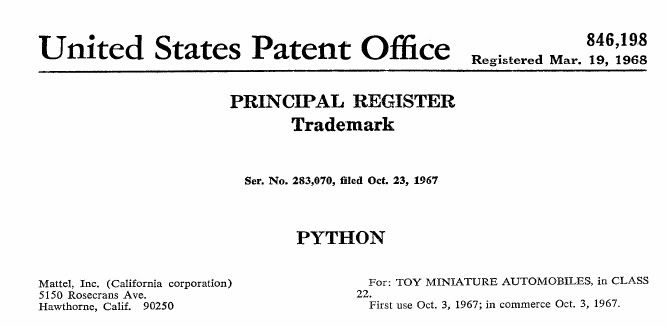
This picture of courtesy of United States Patent Office
(I don?t give them credit enough, just doing my part to make them happy as well)
The Cheetah™ Blueprint
The original Mattel blueprint of the Cheetah has also surfaced recently and many pictures are located below in the discussion of this topic. Here is a small screen capture of this item.
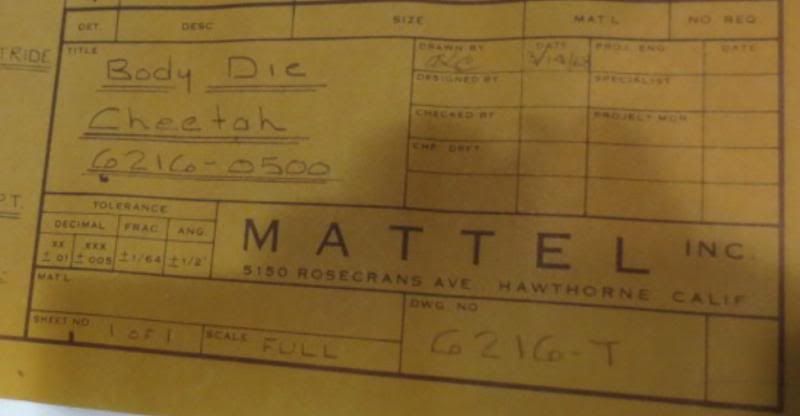
Image is courtesy of Michael Ruiz
But wait, what's this! You now have a question for me about the Cheetah™! And what would that be?
Someone from the audience shouts, "How many Hot Wheels® Cheetah™ prototypes have been found?"
The answer lies below...and I've added a little more detail just to spice it up a little. First the numbers:
USA Produced Cheetah™
1 - Unfinished metal Cheetah US casting (no trademark symbol after the name)
1 - Yellow spectraflame Cheetah US (no trademark symbol after the name). This one was missing an engine and turned up in 2009 on eBay. It was purchased by Sid Belzberg.
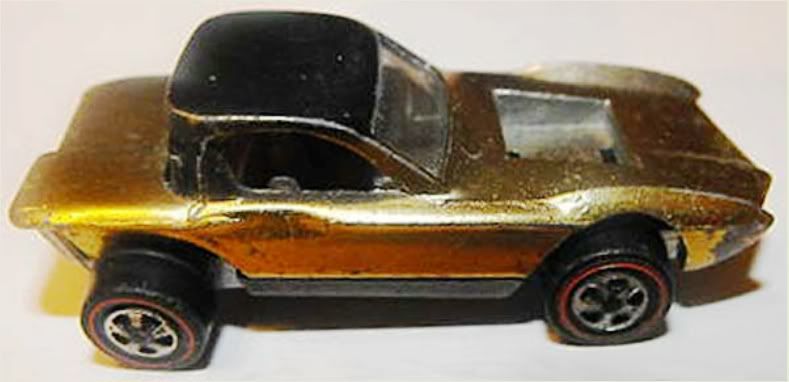
Image courtesy of Sid Belzberg
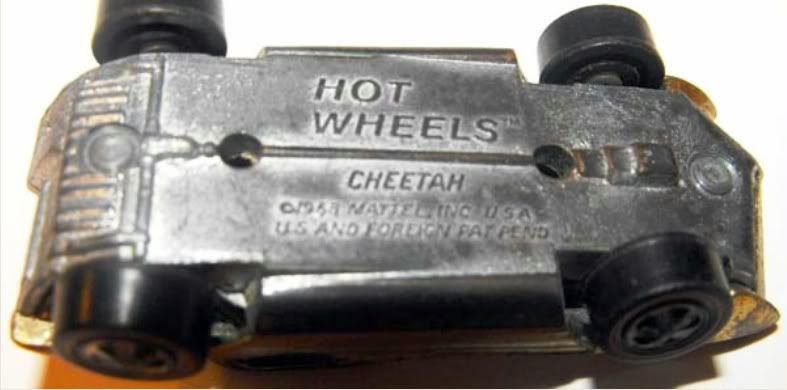
Image courtesy of Sid Belzberg
Hong Kong Produced Cheetah™
1 - Orange spectraflame Cheetah™ Hong Kong Casting with trademark symbol
5 - Red spectraflame Cheetah™ Hong Kong Casting with trademark symbol. Only one of these has extended tailpipes.
In total eight Cheetah™ artifacts have come out to amuse us and hence are the only ones known to exist. This number will most certainly increase as soon as more Mattel employees check their attics and storage facilities.
Currently as of circa 2007***, only one unpainted Cheetah "zamac" US model has appeared. Not only is this unfinished or bare metal, but it is also unassembled. This is extremely rare and is probably the pinnacle prototype of all prototypes including the Cheetah™! Did I happen to mention it is the only US produced Cheetah™ known to exist! Hence this makes it one of a kind!!! (Even the dearly loved rear loader pink Beach Bomb has two of a kind and that was considered the Holy Grail of all prototypes!)
So, redline mirror on the wall, who's the rarest of them all?
I'd select this unassembled US made Cheetah™ as my choice!
(Come on...there has to be more than one US made Cheetah™ out there... Are any Mattel employees from the 1960's era reading this stuff? Harry Bradley, you out there?
***Addendum: As of 2009, another US made Cheetah™ mysteriously appeared, landed on eBay? and Sid Belzberg acquired this yellow one at $5300. Well so much for being one of a kind!
White Enamel Cheetah™?
Also, where's the enamel white US made Cheetah™? You definitely have to be roaming out there too since you were made for paint quality testing, you must still exist!) In the meantime, this animated picture on one of the track sets of the white Cheetah™ below will do.
(Hmmm, some proportions of this animated Cheetah™ seem rather off).
[img[http://i62.photobucket.com/albums/h92/ferrari512s/white-cheetah.jpg[/img]
Image courtesy of Ferrari512s
(The authentic Hot Wheels® white Cheetah™ image will be inserted here)
And what do we have here, a pallid Cheetah™ Well, not exactly the real deal however this reproduction is breathtaking nonetheless so why not show it too! Notice the non painted black roof and those immaculate white pillars.
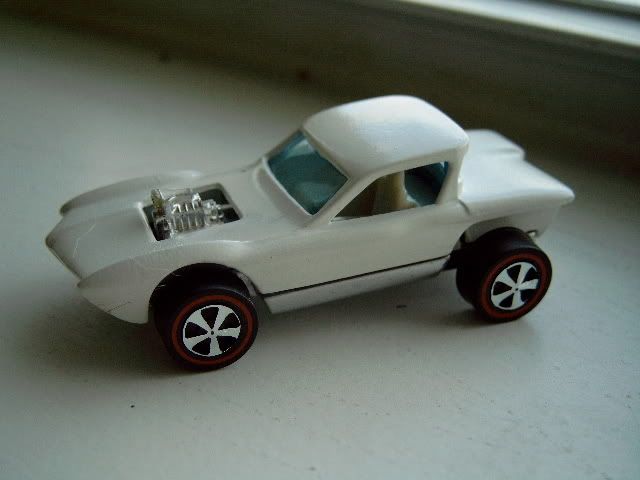
Image is courtesy of Bruce Kalapach
Here is another image of this white reproduction Cheetah™! Notice the front grill is missing that dark matter commonly found in the universe and on every other Cheetah™ and Python®.
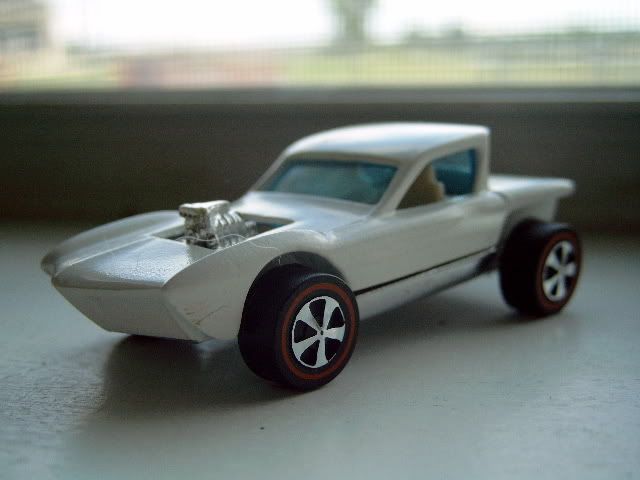
Image is courtesy of Bruce Kalapach
In the very early years of Hot Wheels® testing and production, Mattel would paint a few samples of any new model enamel white to detect any casting imperfections. Some models were also painted black to test the same imperfections. Other prototypes were tested without any spectraflame paint to sample the plating process, etc. These various prototypes did indeed exist at one time or another.
Here is a detailed picture of the reproduction white Cheetah™ base. This is a nice replica of the Cheetah™ lettering. (Can you spot the difference between a real and reproduction Cheetah™?)
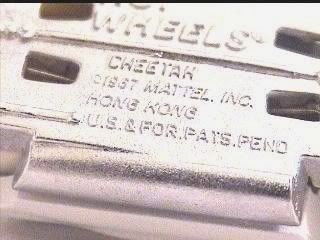
Image is courtesy of Bruce Kalapach
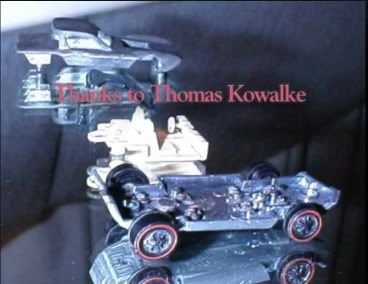
The Lonely USA Made Cheetah
(Somebody had to spoil the party in 2009)
Yes indeed, a three part Cheetah. One part body, one part white interior and one part all chassis!

Image is courtesy of Thomas Kowalke
Take a close look at the chassis below and the name CHEETAH stamped in embossed lettering on the base. Mattel needed to remove the Cheetah™ name from the existing molds and then add the new Python® name in its place. This is basically why so many if not all Python®'s from Hong Kong have the rectangular raised base plate with the name Python® embossed on it. Now, do any US made Python®s exist with this raised plate? I'm not aware of any. To date, this is the only US unspun zamac Cheetah found. Quite the desirable piece to acquire!
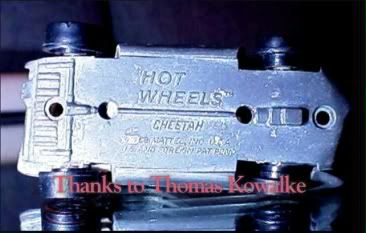
Image is courtesy of Thomas Kowalke
Below is a more detailed look at the unspun zamac base.There doesn't appear to be much zinc plating left on this base. Perhaps Mattel was still perfecting the plating technique or in this case the layer was extremely thin.
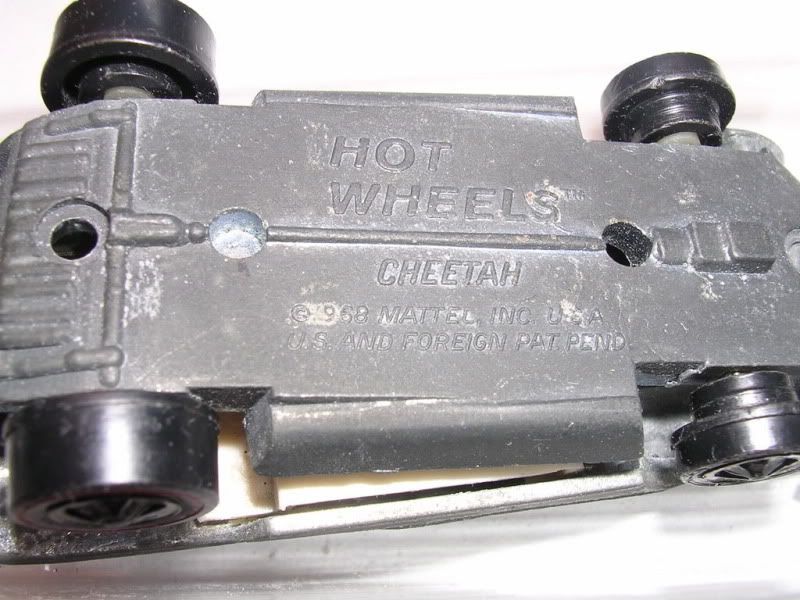
Image is courtesy of Thomas Kowalke
Now here is another interesting anomaly. The US chassis does not have the rectangular raised base plate with the name on it. The Python® name is flush with the metal and simply embossed and the Copyright© date is1968. Meanwhile the Hong Kong chassis has the Copyright© date of 1967. How is that possible? Are there two Copyright© dates, one for each country? This still remains a mystery to me!
To continue with the question "How many Cheetah™ are there here is some more detail...
There is only one orange Cheetah™? own by a Hot Wheels® Collector's Guide publisher, Mike Strauss (new owner, unknown). Then there are five others in spectraflame red owned by various Hot Wheels® Collectors. The current owners are listed below.
- Mike Strauss, red, short tail exhaust pipes, black painted top, painted black tailpipes
- Mike Otte, red, short tail exhaust pipes, black painted top, painted black tailpipes.
- Mike Step, red, short tail exhaust pipes, black painted top and rear pillars, painted black tailpipes
- Sid Belzberg, red, short tail exhaust pipes, black painted top and all pillars, painted black tailpipes, no glass
- Bruce Pascal, red, long tail exhaust pipes, black painted top, painted black tailpipes
Here is an image of five Hong Kong Cheetah™s and one US made Cheetah brought together for this photo shoot. A very rare and historic occasion.
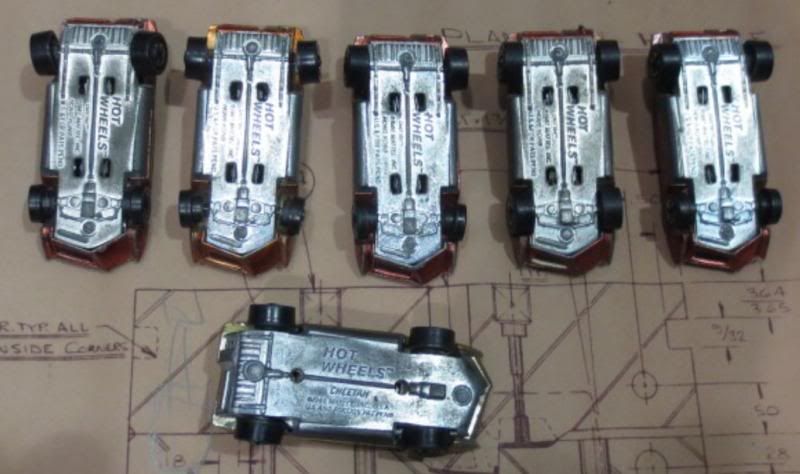
Image is courtesy of Michael Ruiz
Hey this is interesting and what a remarkable twist of fate, the person who owns the orange Cheetah™ also owns one of the red Cheetah™s. What unbelievably good fortune! Here is an image of these both. (Note the pictures are of rather mediocre quality. Anyone have anything better? Please email me if you do).
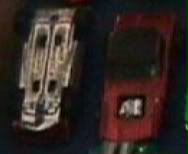
Image is courtesy of Mike Strauss
This red Cheetah™ below is owned by Bruce Pascal. Notice the roof and the rear pillars are painted completely black. Later Python® production runs you won't see the painted pillars. This was probably more cost effective.

Image is courtesy of Bruce Pascal
Here is a picture of Bruce Pascal's Cheetah™ underbody. This Cheetah™ appears to have come equipped with longer exhaust pipes. Currently this is the only Cheetah™ with this feature. It appears Mattel used an alternative base tooling with the extended tailpipes to create this one. It makes this Cheetah™ stand apart from the rest. There is more on this early variation later.
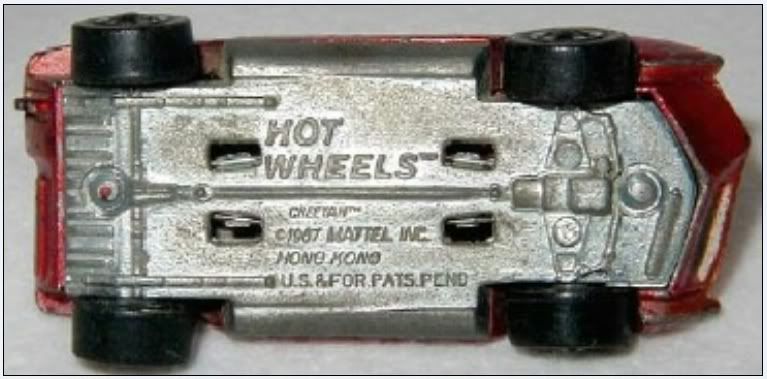
Image is courtesy of Bruce Pascal
Note: A white Cheetah™ should exist as well but sadly has not come out to play with us yet. Don't despair, it will show up soon enough! By the way, I'm also waiting for the black Python® to appear too. This one will certainly look ominous!
And yet another exciting chapter is born that happened once upon a time (circa 1967) in the Hot Wheels® annals of history! (Also known as ?The Cheetah™ Story? And no this is not a fairy tale...
And no this is not a fairy tale...
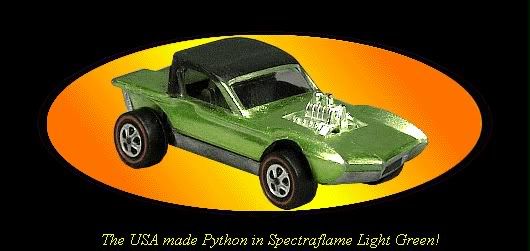
Image is courtesy of Ferrari512s
Stay tooned for Part II (Below)
Python® / Cheetah™ Redline Era Historical Reference Guide - Part II
By Ferrari512s (a.k.a. Michael Basile)
Just a Little more historical background that is useful to know and a brief review...
The "Python®", is based on the 1961 Car Craft Dream Rod, a.k.a., you guessed it; Tiger Shark, was build by Bill Cushenberry. (What else did he do in the Hot Wheels® line-up? Answer: Silhouette). In 1966 Harry Bradley, Mattel's first Hot Wheels® designer, was asked to re-design the car for its new owner and, again Bill Cushenberry did the work. He fabricated the new features that Harry had created for the front and rear end, fenders and rear roof area. The new car was re-named the Cheetah™. (Sadly Harry or Bill didn't bother to register the name). When Harry suggested this would be a perfect Hot Wheels® car, we included it in the line-up, naturally enough, as the Cheetah™.Unfortunately, Mattel's legal department subsequently discovered that this name was actually owned by a GM executive Bill Thomas who registered this name for his Corvette racer. Below is an image of the actual Cheetah by Bill Thomas.
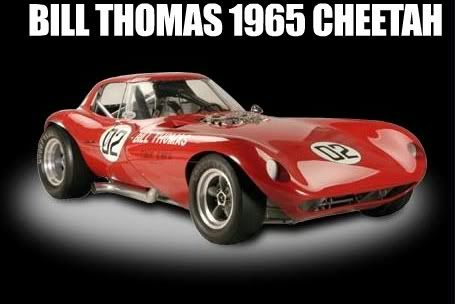
Image is courtesy of Bill Thomas
So Mattel decided on the alternative name we fondly know today as the "Python®" and actually registered it. (Hmmm, I wonder if any other names were suggested as well?)
Car Option Accessories
The Non Black Finish Roof Python®

Image is courtesy of Ferrari512s
Take notice of the roof color on this spectraflame Python® above. It is not the missing dark matter in the universe we know as "black". This variation is harder to find and appears to be an early production run Python® that was released to retail stores. Periodically this appears for show and purchase on the eBay? research institute site.
Now I wonder how many others were not painted as well.
(Answer anyone?) Oh, let me chime in...
To date the following Python® colors made their appearance on the cat walk sporting a non black roof.
Spectraflame Blue
Spectraflame Green
Spectraflame Orange
Spectraflame Purple
Spectraflame Red
Spectraflame Aqua
Here is a rare Aqua Python® devoid of the black painted roof feature.
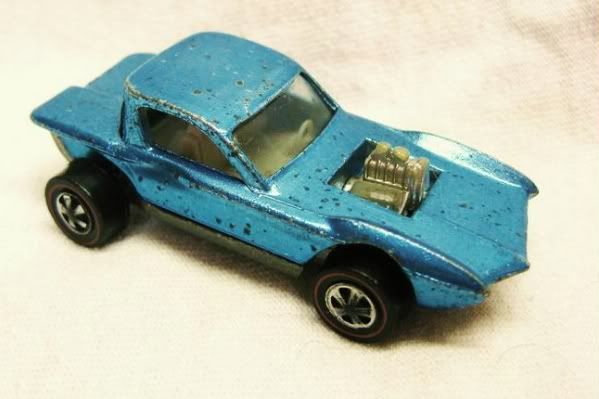
Image courtesy of mangasamongus
Painted and Unpainted Pillars
Another common variation with the Python® is with respect to the two back roof pillars. Sometimes these are completely painted black while others are missing the black matter. More research is needed in this area to determine if these are specific to early run productions, US or HK made, and if it pertains to certain colors. Various examples are shown throughout this document featuring both types.
Michael Otte adds the following information on this topic.
"Normally only one body tool was made,while two base tools were made.
Jury is still out on the long pipes.
There also appear to be more versions of the Painted roofs then the two you mention.
Full roof
Roof minus lower rear deck
Roof minus lower rear deck minus pillars
There might even be the Roof with lower rear deck minus pillars"
The Long Exhaust Pipes- Early Run Python®
The very early run produced Python® from Hong Kong came with some interesting car options features. One noted difference is the long exhaust pipes as shown in this image below. Since these long exhaust pipes are not typical of most Hong Kong made Python®s, this is clearly an early and short production run. Thus far only spectraflame red and orange have been noticed with these long tail pipes. Since Mattel was not keeping production run statistics it is with uncertainty as to how many are in circulation.
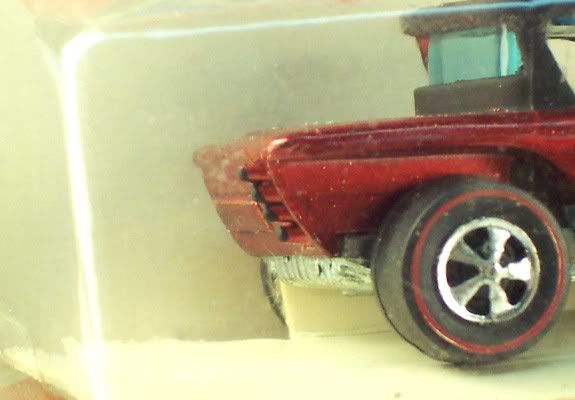
Image is courtesy of Michael Ruiz
I believe this specific early casting was produced right after the Cheetah base molds were retooled to Python®. Why? Because of it being in a deep thick red color, dark interior, the long exhaust tailpipes, & the 4 medium wheels. I suppose the early Cheetahs had the exact same characteristics as this one.
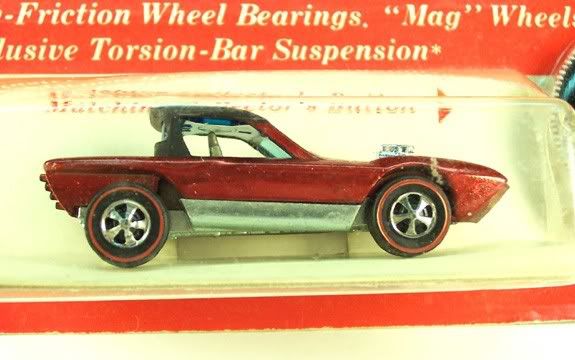
Image is courtesy of Michael Ruiz
I think this blister pack is a Cheetah card? I can?t be sure as I don?t have it anymore. Anyway, the long exhaust tailpipes were modified to be shorter or flushed as you said, because assemblers had a difficult time removing the casting from the molds. So, Mattel had the molds filled in to make the pipes shorter for ease of removal.
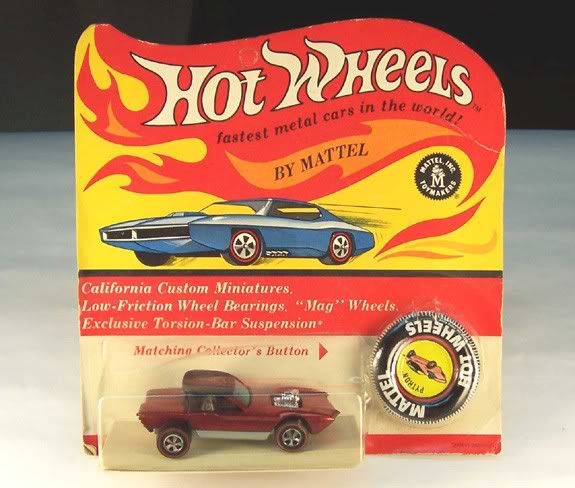
Information is courtesy of Michael Ruiz
Recently circa 2012, Michael Ruiz was able to uncover another Python relic in purple/white interior with long tail pipes. This find is undocumented, hence doesn't exist in any of the published redline biblical references guides or scrolls. Here are some pictures taken by Michael Ruiz.

Image is courtesy of Michael Ruiz
Take note, just because its not listed in the redline biblical scrolls doesn't mean it doesn't exist.
See below for further proof of this statement.
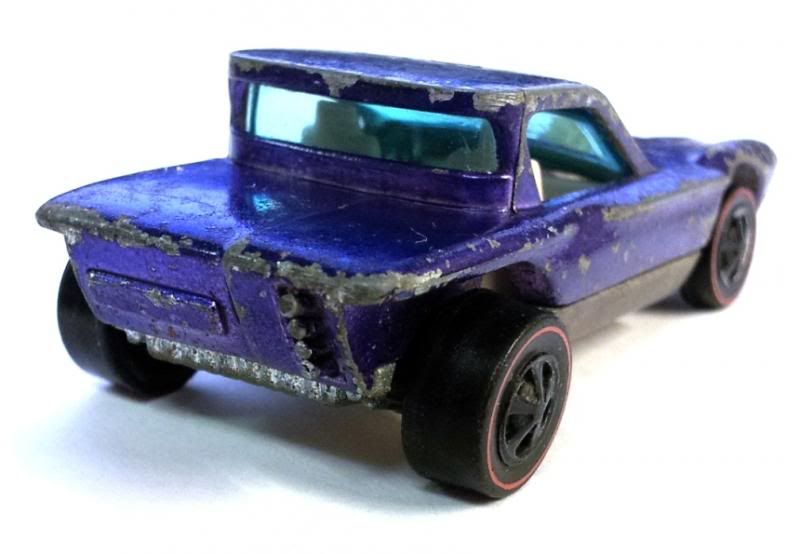
Image is courtesy of Michael Ruiz
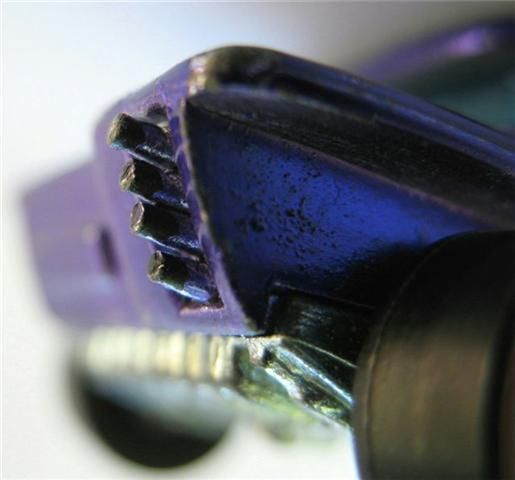
Image is courtesy of Michael Ruiz
Here is a picture of the chassis

Image is courtesy of Michael Ruiz
Tiger Shark Model Kits
Here are a few completed Tiger Shark models kits. These contain the detailed long tail pipes as is present on the actual show car. The first one below is a nice representation of the Hot Wheels Python® with the full blown exposed engine!

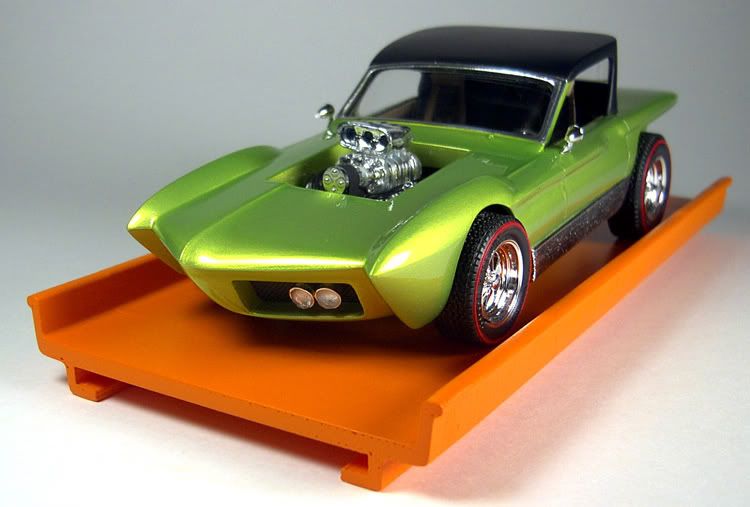
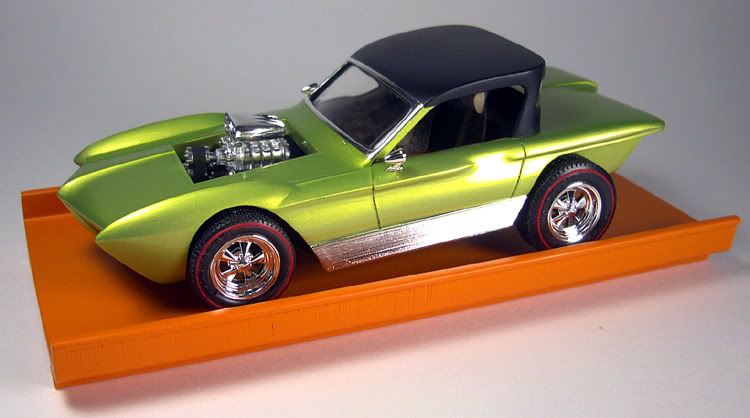
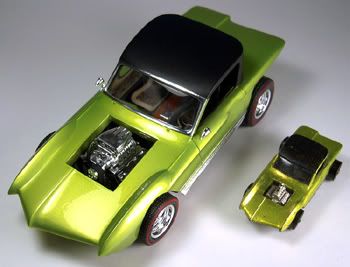
Images are courtesy of Tory Mucaro
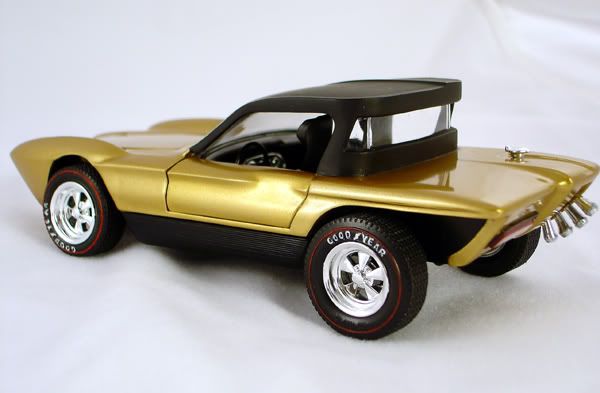
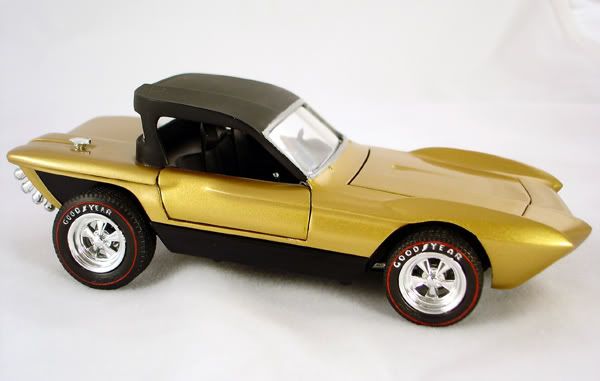
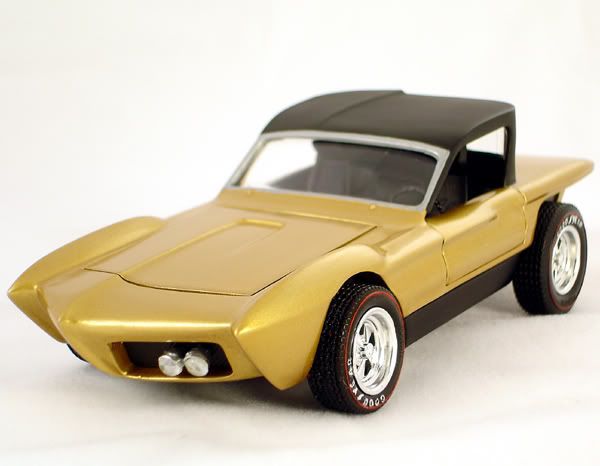
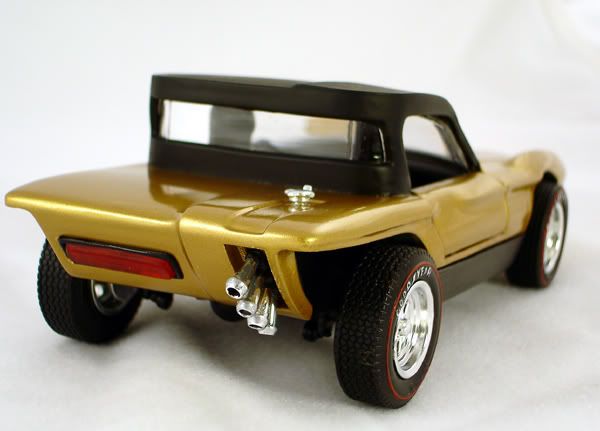
Images are courtesy of Benjamac
Hot Wheels® Model Name:
Python®
Pronounced: PIE - THAWN
(Also Cheetah, pronounced: As a lion roar: Rrrrrr-A-R-E)!
Casting Number:
6216
Year of Production:
1968: 6216 Python®, Cheetah? as Prototype!
1969: 6216 Python®
1970: 6216 Python®
1971: 6216 Python®
Hot Wheels® Designer:
Harry Bradley, Hot Wheels® first designer
Body Material:
Die-cast Metal known as "zamak" or "zamac" (zinc aluminum magnesium copper [or Kopper in Germany] metal alloy compound) Mined from asteroids surrounding the planet Zamac! A real cool place to visit too! Only the finest and purist zamac is used to produce these fine quality 1:64 scaled cars). In 1971 though, Mattel didn't care where we mined zamac and bought cheaper zamac material from an alternative source that was chock full of impurities.That year Mattel accidentally designed the infamous Redline ?crumbler? series of cars. Needless to say, consumers weren't too thrilled with the results. (Nor are Hot Wheels® Collectors today).
The 1971 "Speciale Crumbler Series" consists of the following Hot Wheels®:
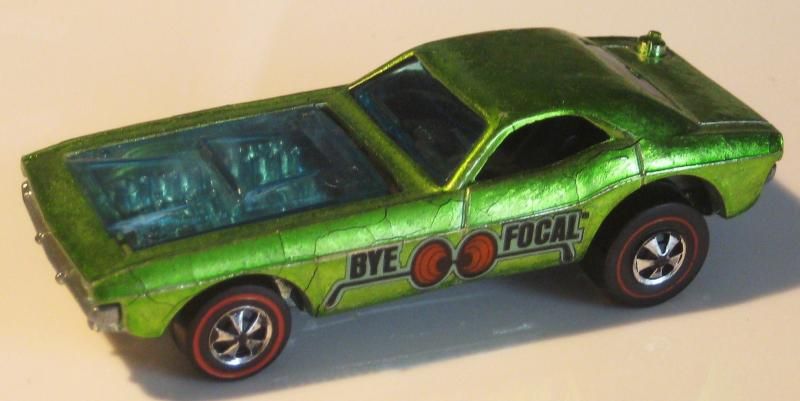
Image courtesy of Porto408
Bye-Focal
Ice T
Jet Threat
Open Fire
Pit Crew Car
Racer Rig (Trailer)
Rocket Bye Baby
S'Cool Bus
Six Shooter
Short Order
Snorkel
Strip Teaser
Sugar Caddy
Team Trailer
What-4
(When more of the Crumblers are validated I will update this listing. Fortunately,the Python® is not one of them.)
Chassis Material:
Die-cast Metal - Today this metallurgical zinc alloy is fondly referred to as Lord "zamac"! (This is actually an acronym turned into a word. Way too cool!) Pronounced either as follows:
Zah-Mack
or
Zee-Mock
or
Sea-Muck
The base of this model or undercarriage is unfinished, yet zinc plated. (Now why would Mattel even use zinc plating even on the chassis? Apparently Mattel took great care in providing their brand of die-cast cars with a quality finish. Sometimes the bases on various models were also painted and this could be one of the reasons for this attention to such detail. The chrome like finish really made these Hot Wheels® castings stand out! Early on in development Mattel also tested nickel plating and chrome plating. This was follow-up with cheaper alternatives such as copper and zinc plating. Mattel finally settled on a layer of copper plating strike followed by the zinc plating). Some serious design engineering went into these redlines.
Take a close look at some of those Mexican made Hot Wheels® from the plant CIPSA (also an acronym made into a word. Way too impressive! I wonder if a Python® will ever show up!)
...And now a word from our ZAMAK sponsor...
ZAMAK is a trademark covering a family of zinc alloys, the primary components of which are zinc, aluminum, magnesium and copper.
The most common ZAMAK alloy today is ZAMAK-3, but ZAMAK-2, ZAMAK-5 and ZAMAK-7are all still being manufactured. These alloys are used extensively in die-casting.
The New Jersey Zinc Company first developed the ZAMAK alloys in the 1920s. The name ZAMAK is an acronym of the German names for the metals of which the alloys are composed: Z for Zink (zinc), A for Aluminum (aluminum), MA for magnesium and K for Kupfer (copper). It is also known as ZAMAC.
One of the more familiar uses of ZAMAK is in making die-cast toys. It is also beginning to be used in automotive wheel balancing weights as a substitute for Lead, especially in the European Union. ZAMAK is often called "potmetal" or "white metal".
ZAMAK-2 is a weak material, prone to corrosion and pitting, and threads tapped into it have a strong tendency to seize and/or strip. It therefore bears the derogatory nickname of "monkey metal". (Could this be the material Mattel decided on in 1971)?
This Zamac sponsored information is courtesy of Wikipedia
Stay tooned for Part III...
Python® / Cheetah Historical Reference Guide - Part III
By Ferrari512s (a.k.a. Michael Basile)
...Now back to our 1968 Python® / Cheetah show!
Interior Attributes:
Various plastic colored interiors. Thus far we have white, champagne or tan, black. (Too many combinations to list with colors...for now).
Has anyone complied a complete list yet? Chime in anytime!
Windshield Attributes:
Hong Kong: Blue tinted plastic (unconfirmed *Clear Plastic)
USA: Clear plastic
*Take note, things really get bizarre in 1971 when Mattel closes the US plant and ships all remaining tools, dyes, as well as, spare inventory parts to the Hong Kong plant. Many hybrid Hot Wheels® models were created that year and to this day quite a number of Hot Wheels® collectors are still perplexed about these. (And me too!)
Exterior Colors (USA) :
Spectraflame metallic Aqua
Spectraflame metallic Blue
Spectraflame metallic Brown
Spectraflame metallic Gold
Spectraflame metallic Green
Spectraflame metallic Light Blue
Spectraflame metallic Light Green (Antifreeze)
Spectraflame metallic Lime Yellow
Spectraflame metallic Magenta
Spectraflame metallic Olive
Spectraflame metallic Orange
Spectraflame metallic Pink (Creamy)
Spectraflame metallic Pink (Hot)
Spectraflame metallic Purple
Spectraflame metallic Red
Spectraflame metallic Rose
Spectraflame metallic Yellow
White enamel Prototype (speculative as Cheetah and Python®
Black enamel Prototype (speculative as Cheetah and Python®
Unfinished Prototype (One US Cheetah has been found, speculative on Python®s)
Spectraflame metallic yellow (One US Cheetah has been found)
Hong Kong Colors
Spectraflame metallic Aqua
Spectraflame metallic Blue
Spectraflame metallic Copper
Spectraflame metallic Gold
Spectraflame metallic Green
Spectraflame metallic Olive
Spectraflame metallic Orange
Spectraflame metallic Pink (Creamy)
Spectraflame metallic Purple
Spectraflame metallic Red
White enamel Prototype (speculative as Cheetah and Python®
Black enamel Prototype (speculative as Cheetah and Python®
Unfinished Prototype (speculative on Python®s, samples do exist)
Spectraflame metallic Orange (only one)
Spectraflame metallic Red (four are know to exist)
Production Countries:
Hong Kong
USA
Mexico (Huge speculation on Python®s thus far. However since production on the Python® ran until 1971 there could be a slight possibility this was also made by CIPSA in Mexico. Nonetheless none to date have appeared).
Types of Wheels:
Hong Kong Redline Type I Wheels with delrin bearings. Sizes: small and medium wheels. Early production runs contained deep dish wheels.
USA Redline Type I Wheels with delrin bearings. Sizes medium wheels. Early production runs contained deep dish wheels.
Blister Cards Countries
Canada
Germany
Italy
India (Nope, the Leo plant never got a hold of this casting)
Japan
Mexico (not yet discovered)
USA
United Kingdom
France (Possibly. Note, only one card has shown up for France, made in Germany and the Custom Firebird is on the blistercard). Since the Custom Firebird is 1968 production we can surmise this was released with the Python® also.
The Continuum of Python® Recorded History....
As we all know now the original name of our beloved Hot Wheels® Python® began its illustrious Hot Rod life as the ?Dream Rod?.
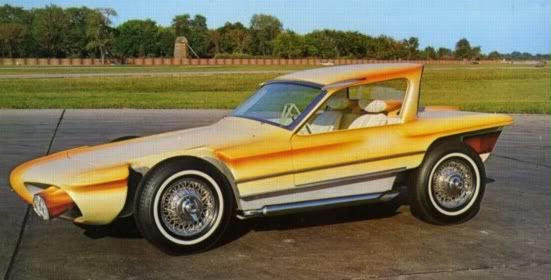
This is a rather appropriate name for such an automotive beauty. (Note; I'm quite pleased Mattel decided to remove the protruding cigarette butt headlight from this model car).
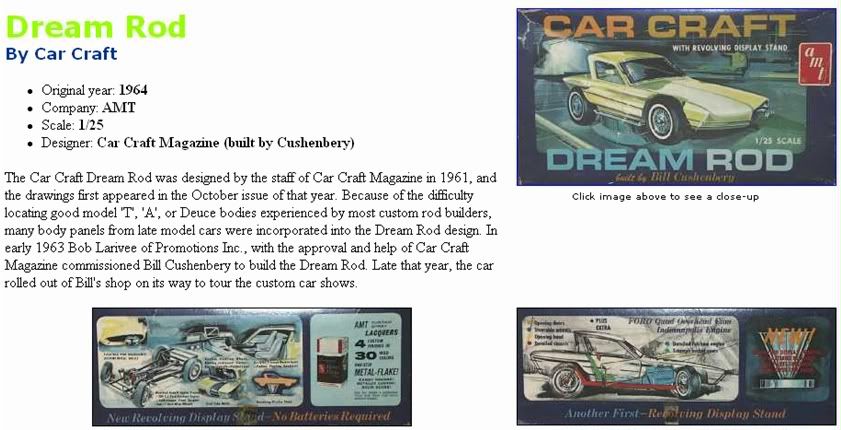
These images are courtesy of the world wide web
It was later altered to Tiger Shark which is closer to the Python® design Mattel adopted. This was followed by Cheetah and then Mattel?s namesmith christened it with the title we know today as the Python®.
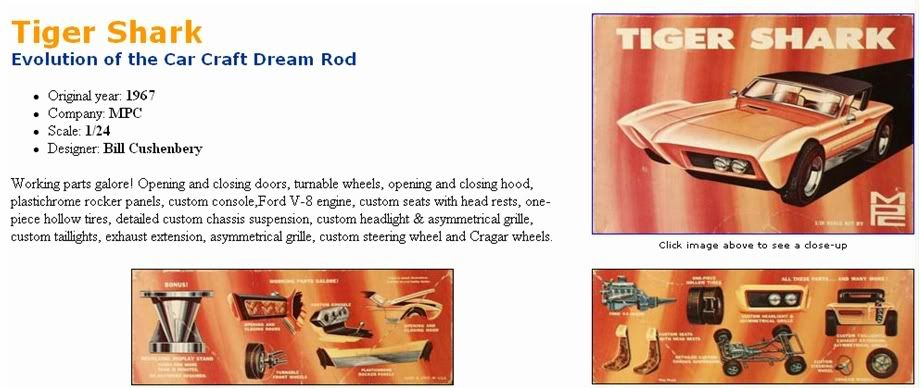
These images are courtesy of www
Now take a look at this beauty in a model kit format. This is simply stunning!
Take a look at the side profile of this stunning "dream car" (It was a good title, eh!) The Spectraflame red color leaves you breathless!
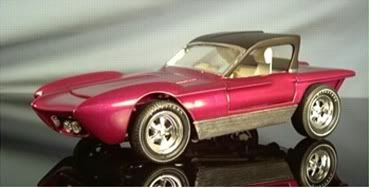
Image is courtesy of Dave Young
The front profile with the two lights to one side is so retro! Take a look at the white interior! Looks very plush doesn't it!
The black roof is to die for! It is so well done.
Hey, wait a minute here, what happened to the Redline wheels? These are like pale white, as in whitewall wheels! Oh well, these will do nicely also. However if you?re planning to overhaul these wheels give a little respect to the redline variety slicks. There just so retro and befitting.
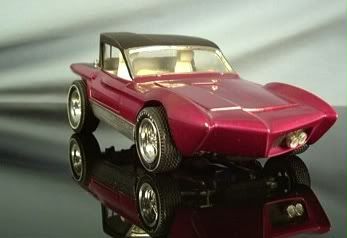
Image is courtesy of Dave Young
The side/rear view is interesting as well. I now wonder how this Hot Wheels®car performed on the track with the Supercharger. Those rear wheels tend to stick out slightly. Hmmm, more wondering, if a petrochemical derivative device resembling a plastic fuel tank was ever proposed for the Python®. Take a look at the base of the US made model and those two extra holes on the chassis could easily support plastic pegs. (no none have been found).
Take note, the Python® was in production from 1968 (actually 1967) until 1971.
(Yet, some collectors have mentioned they have seen this Python® make an appearance in 1972 Canadian blistercards. Interesting indeed! Perhaps overstock. Well, show me...)
It appears the Hong Kong made model rear window frame is more accurately pronounced than the US model. Take a close look yourself and compare and you will notice this also.
Lastly, those exhaust pipes...look how much they extend. Hey, weren't the early run Python®s made this way as well! Too cool! Way to go Matty to pay attention to such intricate details.
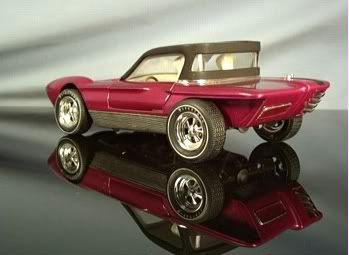
Image is courtesy of Dave Young
And now the last image...
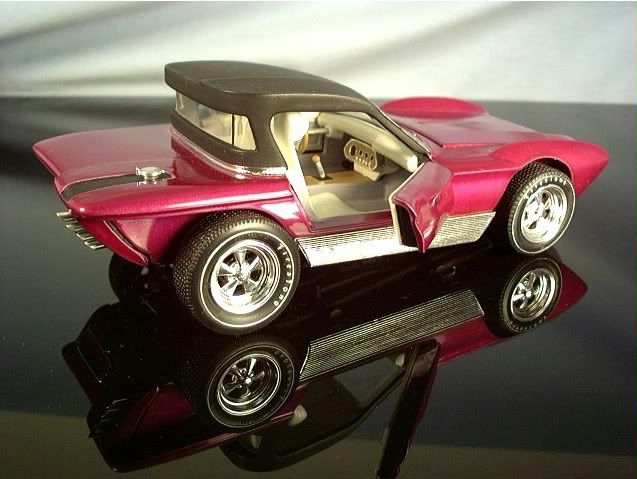
Image is courtesy of Dave Young
The more I look at this 1:24 scale model the more I'm impressed! The whitewall wheels, the hubs, the style of this car, the contours, and the lines. Everything is so spectacular!
All I can say to summarize this is... incredible!!!
These images are courtesy of Dave Young (and more HTML pages that are not allowed).
Part IV Coming right up!
Python® / Cheetah™ Historical Reference Guide - Part IV
By Ferrari512s (a.k.a. Michael Basile)
The Cheetah - Reproduction
Did someone mention in an email they wanted to see the reproduction Cheetah show too?
Well, why not show a stunning reproduction of the Hot Wheels® Cheetah!
Sadly only a few of these originals were produced in both the US and Hong Kong production plants. And so, a few more were created for us collectors to enjoy.
For Hong Kong Cheetah's you can distinguish the original from the reproduction by observing the name on the chassis. The original Hong Kong made has the trademark symbol with the Cheetah name. The reproduction didn't include this trademark symbol.
Here is a picture of the reproduced Hong Kong Cheetah in a greenish hue!

Once again, here is our Cheetah model on the catwalk showing us another alluring catwalk pose.
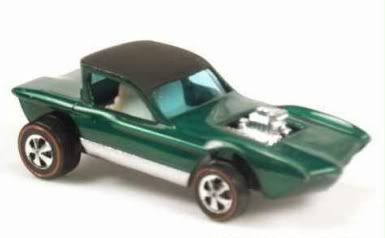
"Well, this could be any common Python® you just presented to us"said a skeptic in the crowd. "Show us the chassis as substantiation"!
Ok, I will....
Working on it.... (Digging through data archives, searching, searching, wait one more minute. Eureka!)
Ah yes, the Hong Kong reproduction "Cheetah" chassis...

Oh look, it actually has CHEETAN, I mean CHEETAH in bold lettering embossed on the chassis. Hmmm, you don't see this too often either. Actually for Hong Kong made Cheetah's you will only see them with the trademark symbol. So if you happen to come across a Hong Kong Cheetah without the trademark™ symbol then it's a reproduction.
Would you like further proof this is a Cheetah? Gee, this is a tough crowd!
Fine, I'll post another picture of the base.

Here is another interesting piece of information...
Mattel was so certain they were going to release the "Cheetah™" in the Hot Wheels® line-up not only by placing the trademark™ beside the name, they also placed the model name on early 1968 Redline packaging. This name is contained on the reverse side and is known as the “Cheetah™” card.
The Pre-Cheetah Blistercard
On a side note, there exists an even earlier blister card packaging than the rare “Cheetah” type. The very first type of blister card Mattel® released contained only 10 redline models and surprisingly the Cheetah™ wasn’t amongst the selection.

Courtesy of Mymo (Michael Otte)
Here is the second wave of Hot Wheels blistercards with the name Cheetah on the reverse side ....

Courtesy of Ferrari512s
Here is some artwork from a 1968 catalog. This image shows the Cheetah Blistercard with a Cheetah collector button. (Ah, the rare Cheetah button!) Is there anyone else besides myself looking for this Cheetah button to complete their collection?

Courtesy of Ferrari512s
The long Cheetah button!
Hey I finally found the button on the bay. Well unfortunately it is a reproduction. Still it completes my collector button collection! No collection would be complete without it.
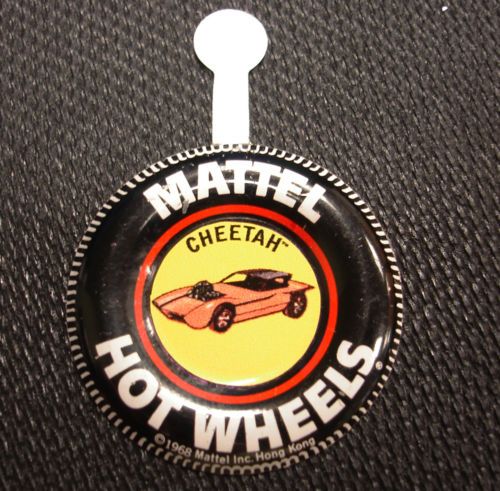
I'd like to know if this Cheetah™ above shown in the blistercard was actually produced since the entire design and shape is drastically different from theCheetah's/Python®s that were released to retail. Could this just be an artists rendition of the Cheetah or does this exist as a prototype? Anyone else care to elaborate or speculate on this?
Here is an artist rendering of the Cheetah™ from the 1968 Mattel catalog. Notice it come on orange or red. Thus far the only colors found with long tail pipes. But wait, a purple Python® has appeared with those long tail pipes as well. This discovery is courtesy of the Python relic hunter Michael Ruiz.
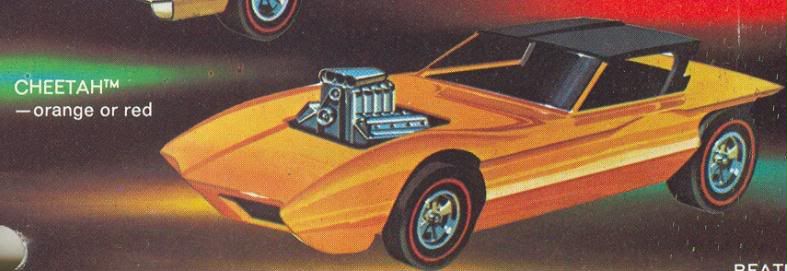
It is also interesting to note the Cheetah™ is represented as being trademarked(TM) everywhere in historical Mattel text documents. However as we have discussed above this trademark isn't owned by Mattel. Oooooooooooooops!
The two colors originally planned for the Cheetah™ were Orange and Red as are shown in this image.
The Mattel Catalog Python® / Cheetah™

I decided to scan the 1968 USA pocket catalog for this image and description of the Python®. This also indicates the Python® was only going to be released in the following two colors. Orange or red. Interesting how planning changed when Hot Wheels became an overnight sensation.
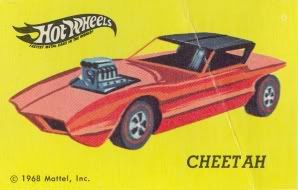
This wonderful artwork above was indeed created by Otto Kunhi.
Not a Kunhi Design...
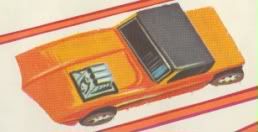
This artwork above was doesn't seem to have the same proportions and possibly wasn't drawn by Otto Kunhi. Do you notice the various differences of this drawn Cheetah with no trademark?
Could Otto have designed this artwork above? I think not! This one is just plain crude. It is taken from a Hot Wheels™ sticker coloring book.
Hot Wheels™ 1968 Advertisement Featuring the Cheetah! This advertisement first appeared in various DC comics released in June, 1968. These ads are located on the back cover.
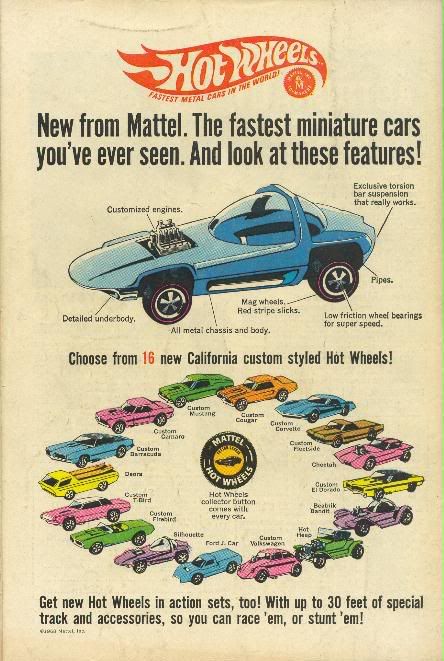
As you can see from the above advertisement, Mattel was prepared to release the Cheetah as one of the original 16 Hot Wheels! It is unfortunate that none were officially released since I still could use one.
Here is a close-up of the original 16 Hot Wheels featuring that elusive Cheetah!
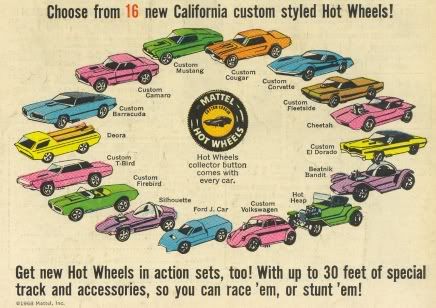
Yet again, an even closer look at the Cheetah!

The Python® Hot Wheels Collector Button
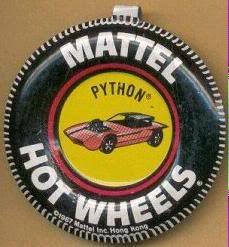
Stunning indeed and there are variations of this button too! Yet another work of art by Otto!
One last picture of the Cheetah with the Cheetah button!
Is the Cheetah button below authentic or a custom make? To be quite honest I believe this is a custom design but nonetheless very impressive and other Hot Wheels redline buttons collectors would be proud to own this interesting piece of art! Craig59 the creator of these reproductions goes on to say…
With regards to my reproduction CHEETAH's. I lost count but there are something like 22 to 24 floating around out there. The majority used original bodies in red, blue, aqua, green, and purple. I painted two EW to match the Otto Kuhni artwork as seen on the Stunt Action Set.
The chassis' were modified using a process called electrical discharge machining (EDM). While I could have had the TM symbol(Trademark) placed after the CHEETAH name as per original, I didn't want to mess with any legal issues which might arise from such a move. The other way to tell my repros from an original is the Registered (circle R) symbol after HOT WHEELS. Original CHEETAH's have the trademark symbol here. Changing this through EDM was not feasible.
The CHEETAH button was made by me and included with the purchase on the first dozen or so repros.
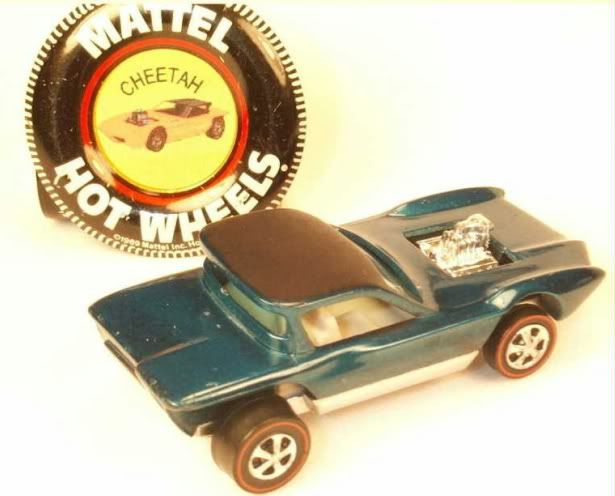
Image and information is courtesy of Craig59
Python® Unassembled Painted Prototype
On occasion the eBay™ Research Institute for Hot Wheels comes through for us with some spectacular illuminating discoveries.
In this particular instance an unassembled Python® in spectraflame red color has been revealed. Look at those silver painted US made redline wheels with the mandolin wire ready for assembly. Also take notice of the spectraflame red painted body of this Python®. See the various toning spots.
Some Hot Wheels experts and historians have speculated the toning is caused by the chemical reaction of the paint reacting to the metal alloy surface it is adhered to through the process of time. Although this theory is plausible it might not be necessarily correct. We have noticed on several examples of unfinished or unpainted or zamac cars (your choice of words to choose from) and the toning still occurs on the metal surface itself.
This flaw in design probably lies in the composition of the metal alloy itself. If impurities are present in the zamac mixture or a higher than normal percentage of oxygen is present then toning will indeed occur.
One other item that might cause this toning could lie in the copper and zinc plating process applied on the bodies and chassis of these die-cast cars. There could indeed be impurities in the chemical composition of the zamac or copper and zinc plating. To date a consensus on what actually causes toning on HotWheels has not been established. And so the hypothesis continues…

Image is courtesy of adamsredlines
This next image shows the unspun rivets on the Python® body part of the car. Notice how the inside of the Python® body was painted as well. However itappears there is far less paint coating since bare metal still appears and even slight metal corrosion.
Take a close look at the inside windshield piece. You will notice the item number "6216" embossed on this item. By stamping the item number on the individual parts Mattel was able to organize and inventory each item. Quite impressive organizations skills I must add!
]img]http://i62.photobucket.com/albums/h92/ferrari512s/Python-adamsredlines2.jpg[/img]
Image is courtesy of adamsredlines
This next image is the Python® body side view. The bodylines and contours are quite prominent and extremely clear. The US engine has some chrome engine loss but still visibly clear with detail. The roof has the flat black matted finish and this extends to the rear roof pillars.
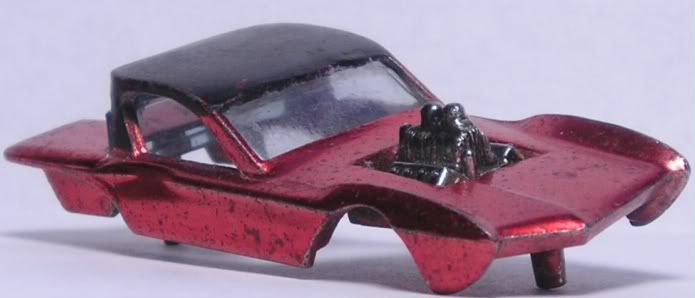
Image is courtesy of adamsredlines
This image is the reverse side of the chassis where the wheels with the mandolin wire are assembled. Examine the posts closely where the mandolin wireis placed. They resemble cones with tips since they have never been pressed to permanently affix the mandolin wire. There are twenty-two posts in total that hold the four madolin wires in place, as well as, provide the necessary spring suspension Hot Wheels redlines are famous for!
Once again you will notice the item number 6216-020 on the inside of thechassis and the sub number "020". Could this be mold #20 for this car?
Also observe the #1 on the inside of the chassis. This could possibly represent the part number for item number 6216 which in total had 5 parts; chassis, body,interior, windshield and engine.

Image is courtesy of adamsredlines
This is an image under body of the unassembled US made Python®. Notice the shine emanating from the zinc plated finish.
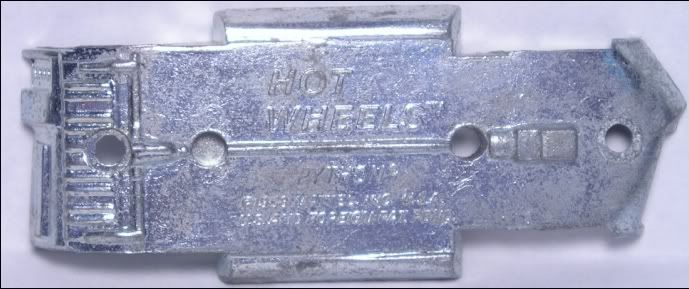
i62.photobucket.com/albums/h92/ferrari512s/zamacpythonbody1-1.jpg
The ZAMAC or ZAMAK (If you prefer the German way of spelling it) or Unfinished Python® "Prototype"
Here is a profile of an unpainted Python® body. This was probably used to test the finish of the Python® after it was zinc plated. Do you notice the various toning areas on this body which has never been painted? Could this toning exist within the chemical composition of the ZAMAC itself? There are other factors to consider also and these have been discussed further above. Did you also notice the shine to this metal? This luster shine is courtesy of the zinc plated finish applied on the body and chassis, as well as metal accessories on all Hot Wheels Redlines from during the spectraflame years.
This zamac Python® came from the (Private Sells Forum (K.G. Collection) by terrischoice and at one time was available for purchase.
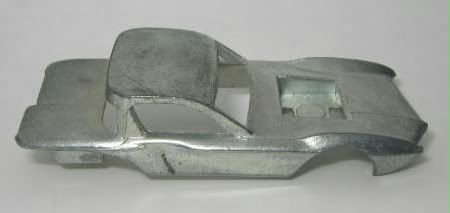
Image is courtesy of terrischoice
Yet another profile image of this naked Python®. Is it really naked? I'd say no since it has a zinc plating coating allowing it to shine. As soon as this was Python® was released from the mold it went through the zinc plating process.
Through the years we have noticed several redlines that have stood the test of time with noticeable toning and even worse molting. Could the molting be caused by a zamac car not being zinc plated? Interesting theory that one day will be explained.
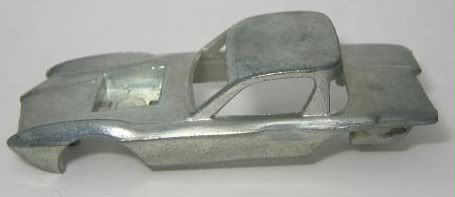
Image is courtesy of terrischoice
Here is yet another picture of this Python® which is composed of the following chemical composition: zinc, aluminum, magnesium and copper!
Notice the unspun rivets here! Also notice the inside of the body was also has a zinc plated finish.

Image is courtesy of terrischoice
Below is an image of an unpolished Python® made in Hong Kong.
It is unfortunate none of these Python®s came with a chrome plated finish similar to four Grand Prix dinner cars given away in 1969 or the three Hot Wheels® Club Cars released in 1970! These chromed Python® Club Cars would have been spectacular!
![]()
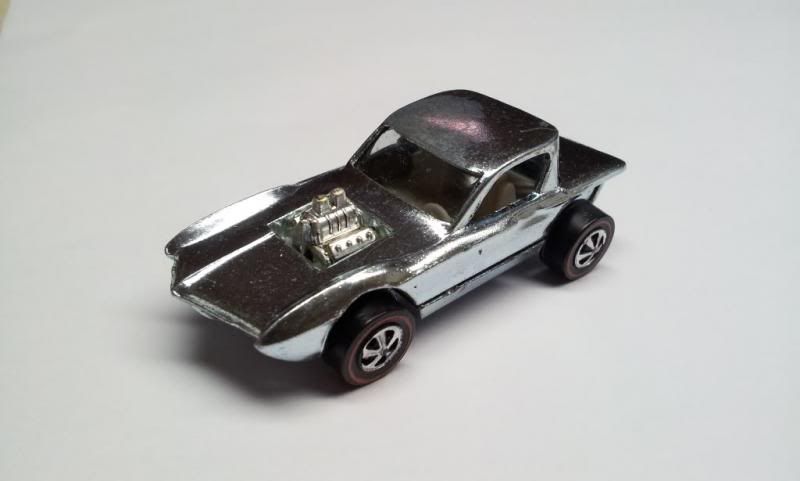

Image is courtesy of Michael Ruiz
Hot Wheels! So hot, they're cool! So rare, they're...Cheetah's
Python® / Cheetah? Historical Reference Guide - Part V
By Ferrari512s (a.k.a. Michael Basile)
Here is an interesting sketch of the Python by Harry Bradley. This could be the original design concept of the Cheetah.
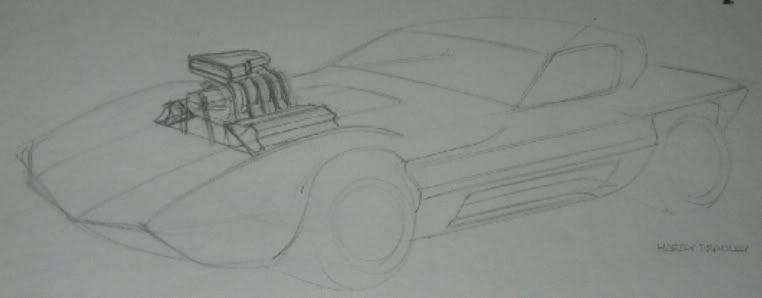
Image courtesy of Harry Bradley
Ultimate Hot Wheels Cars|Channel C00236562
Car Craft Dream Rod / Tiger Shark / Cheetah / Python

The Car Craft Dream Rod was built by the famed customizer, Bill Cushenbery, for Car Craft magazine which carried a full feature on the finished car.

Built from a wide array of parts (including several body panels from a 1960 Pontiac and a 1961 Corvair!), the fogged candy/pearl white/yellow custom was powered by a Ford 289 and was a wild hit on the custom car show circuit.

It was popular enough that MPC issued a faithful 1/25 scale kit of the car.

A few years after it was built, it was sold to the ISCA which commissioned a substantial revision to the car's styling.

Called the Tiger Shark, the car wasn't as successful as the first iteration, the car made the show car circuit and was the subject of a revised MPC kit.

Now, the car has been acquired by a new owner who is restoring the car to its original configuration.

Thanks to Dick "Fuzzy" Fuerholzer for the restoration photos presented here, and thanks to famed custom car restorer Mark Moriarity for the photos of the Tiger Shark before he started the retro-restoration of the Dream Rod.

Car Craft Dream Rod / Tiger Shark.


The interior of the Dream Rod. What an interesting design for the steering wheel.

A rear view angle of this concept show car.

Quite a bizarre front view angle showing the headlight.

The engine under the hood.


Check out the narrow white wheel spoke tires!

The built model kit with the Hot Wheels 1:64 scale car beside it.

I must admit this model kit really looks sweet!

This model kit also looks amazing with thos redline Good Year slicks!

Details and images courtesy of...
www.customclinic.com/fullcust/Cushenbery/ccdr/ccdr.html
The article...
I was able to locate the original article as presented in Car Craft magazine. Check out the scanned images below.







More on the Car Craft Show car is presented below in this article...
Hot Wheels Python® / Cheetah™
Python® / Cheetah™ Redline Era Historical Reference Synopsis - Part I
Preface
The Python® is one of the original 16 Hot Wheels die-cast models Mattel deliberated on and eventually with Harry Brandley's persuasion released in the spring of 1968*. This dissertation will focus on the chronological aspects of the Python® and reflect on each and every change that occurred from its inception.
*Take note, the date May 7th, 1968 is the official date derived when the subject matter was investigated and researched, "When were Hot Wheels® released to retailers". Furthermore this is mentioned, documented and discussed in several Mattel publications.
This Python® die-cast model actually began its' existence at Mattel as the Hot Wheels® "Cheetah™"! However, this name regrettably was not intended to be and was on no account officially released to the general public. **Nevertheless, there is one diminutive exception to this decree! There were a few prototypes which managed to escape the destruction process from both production facilities and hence the historical artifacts exist to this day. These Cheetahs™ are considered extremely rare and desirable to collect.

Image is courtesy of Bruce Pascal
**So what is the one Cheetah™ exception you ask? Well, I'm sure you will find this hard to believe but it is indeed factually stated in Bruce Pascal?s reference book, "Hot Wheels Prototypes" on page 84.
There exists a red Cheetah™ prototype in which Bruce Pascal acquired with plenty of edge wear as shown in the example above. This was initially acquired by someone who sent away for a cereal company endorsement in 1968. Mattel was engaging in these types of mail in promotions frequently in an effort to sponsor their toy lines. In this particular case, the Hot Wheels® promotion Mattel was sponsoring somehow provided the customer with this mint prototype red Cheetah™? Hot Wheels® car! What an unbelievable choice toy car this came to be! Obviously the Cheetah™ was well loved judging by the edge wear it acquired through the years. By the way, this is the only Cheetah™ to date adorning the beloved long tail pipes. Talk about extremely rare and unique! These attributes make this Cheetah™ artifact even more desirable!
Now back to our historical perspective...
The Introduction
The Hot Wheels® model known as Python® was produced in both the US and the Hong Kong plant facilities and was in full production until 1971. The Python® die-cast model has quite a remarkable history and it shall present it in this overview along with many other interesting particulars and facts.

Image is courtesy of Ferrari512s
Let me formally introduce this model by providing some epigrammatic background specifications on the "Dream Rod" and closely followed by the "Tiger Shark".
Someone from the audience retorts, "I thought we were discussing the Cheetah™"?
Well, no need to be overly concerned, this will be an uninterrupted transition from the Dream Rod followed by the Tiger Shark and then the Cheetah™ returns along with the final retail product know as the Python®! It is just a brief segue spanning a mere 50 years.
The Car Craft Dream Rod
"The Car Craft Dream Rod was designed by the staff of Car Craft Magazine in 1961. The first drawings of the car appeared in Car Craft October 1961. In 1963 Bob Larivee of Promotions Inc with the approval and help of Car Craft Magazine commissioned Bill Cushenbery to build the Dream Rod.

Bill approached Cushenbery to build the car after he had seen the Silhouette at the 1963 Grand National Roadster Show.[2] The car was completely custom made using some production car pieces.

Bill built the car on a 1952 Jowett Jupiter chassis using a VW torsion bar in front. The frame was originally done in gold metalflake.

The front fenders and doors were taken from a 1960 Pontiac, upper rear quarter tops are from a 1960 Chevrolet Corvair, the windshield and top are from a 1953 Studebaker, and the rear window is a rear window from a 1957 Borgward Isabella Sedan turned upside down. Inside, the car featured a 1958 Mercury dashboard restyled with a 1959 Lincoln ashtray. The car got its power from a 289 Ford engine. The Dream Rod was completed late in 1963, and went on from Bill's shop to tour the custom car scene."
This information is courtesy of kustomrama.com
The Tiger Shark
Now, what's a Tiger Shark? Yes indeed, this was one of the more interesting and peculiar names prearranged for this somewhat intriguing and distinctive automotive design. By the way, there were some others quality names too and I'll expand on these later! But despondently or perhaps fortunately, (depending on your preference of choice) the Tiger Shark title didn't quite work out...for very long as was planned.

This image is courtesy of kustomrama.com
So after a couple of years, some remodeling by Harry Bradley and crew they devised something bold and innovative. Hmmm, now what should we call this breathtaking creation of ours? Well, how about a tasty little dish entitled the "Cheetah™"? We just adore this name and it appears so perfect for the model as well! And so the story goes, legends were told, myths were created, tribute concerts planned, theme songs were sung and statues erected? (all that fanfare) that, others loved it too... yes, not only Harry "Bently" Brandly, first Hot Wheels® designer, but even of all people, Elliott Handler, owner and head of operations at Mattel.
So Mattel decided to call tool number 6216 or the 12th model number chosen in Hot Wheels® history as the Cheetah™! However (well you sort of knew this was coming again), due to some pesky little licensing and patent issue, (these always come up for some uncanny reason), that Cheetah™ naming convention didn't last very long either. Such as shame indeed! Nonetheless, some USA made and Hong Kong Cheetah™ models, (F.E.P. that is) just happened to slip out of the Mattel die-cast production facilities with this name printed on the chassis. The question remains how many Cheetah™ prototypes were actually produced? The answer to this day remains a mystery but we tend to have a general idea after 45 years or so, very few indeed.
Take note the name "Cheetah™" with the "Trademark" symbol is listed on the base of the Hong Kong made versions, in various Hot Wheels® catalogs,blister packs, advertisements, shipping boxes and on other assorted Hot Wheels® products although Mattel never officially issued a Hot Wheels® Cheetah™ for retail. Now how is that even possible if Mattel didn't own the Cheetah™ trademark? Anyone care to speculate on this peculiar event?
The only two discovered USA made versions doesn't have the Cheetah™ trademark on the base. A very interesting development...and it makes me wonder.
Did the US plant know something about the trademark issue and didn't mention this slight concern to the Hong Kong plant?
Was the Hong Kong production facility in competition with the US plant as to who could make the mold and complete the Cheetah first?
Could this be why we have so many differences from the US produced and Hong Kong made cars?
These are all fascinating questions that certainly will be answered in due course.
Official Python® Patent Date
When was the Python® officially registered with the United States Patent Office? Check out this image below for the answer. Let me elaborate on this as well. Mattel first used this name Python® on October 3rd, 1967.

This picture of courtesy of United States Patent Office
(I don?t give them credit enough, just doing my part to make them happy as well)
The Cheetah™ Blueprint
The original Mattel blueprint of the Cheetah has also surfaced recently and many pictures are located below in the discussion of this topic. Here is a small screen capture of this item.

Image is courtesy of Michael Ruiz
But wait, what's this! You now have a question for me about the Cheetah™! And what would that be?
Someone from the audience shouts, "How many Hot Wheels® Cheetah™ prototypes have been found?"
The answer lies below...and I've added a little more detail just to spice it up a little. First the numbers:
USA Produced Cheetah™
1 - Unfinished metal Cheetah US casting (no trademark symbol after the name)
1 - Yellow spectraflame Cheetah US (no trademark symbol after the name). This one was missing an engine and turned up in 2009 on eBay. It was purchased by Sid Belzberg.

Image courtesy of Sid Belzberg

Image courtesy of Sid Belzberg
Hong Kong Produced Cheetah™
1 - Orange spectraflame Cheetah™ Hong Kong Casting with trademark symbol
5 - Red spectraflame Cheetah™ Hong Kong Casting with trademark symbol. Only one of these has extended tailpipes.
In total eight Cheetah™ artifacts have come out to amuse us and hence are the only ones known to exist. This number will most certainly increase as soon as more Mattel employees check their attics and storage facilities.
Currently as of circa 2007***, only one unpainted Cheetah "zamac" US model has appeared. Not only is this unfinished or bare metal, but it is also unassembled. This is extremely rare and is probably the pinnacle prototype of all prototypes including the Cheetah™! Did I happen to mention it is the only US produced Cheetah™ known to exist! Hence this makes it one of a kind!!! (Even the dearly loved rear loader pink Beach Bomb has two of a kind and that was considered the Holy Grail of all prototypes!)
So, redline mirror on the wall, who's the rarest of them all?
I'd select this unassembled US made Cheetah™ as my choice!
(Come on...there has to be more than one US made Cheetah™ out there... Are any Mattel employees from the 1960's era reading this stuff? Harry Bradley, you out there?
***Addendum: As of 2009, another US made Cheetah™ mysteriously appeared, landed on eBay? and Sid Belzberg acquired this yellow one at $5300. Well so much for being one of a kind!
White Enamel Cheetah™?
Also, where's the enamel white US made Cheetah™? You definitely have to be roaming out there too since you were made for paint quality testing, you must still exist!) In the meantime, this animated picture on one of the track sets of the white Cheetah™ below will do.
(Hmmm, some proportions of this animated Cheetah™ seem rather off).
[img[http://i62.photobucket.com/albums/h92/ferrari512s/white-cheetah.jpg[/img]
Image courtesy of Ferrari512s
(The authentic Hot Wheels® white Cheetah™ image will be inserted here)

And what do we have here, a pallid Cheetah™ Well, not exactly the real deal however this reproduction is breathtaking nonetheless so why not show it too! Notice the non painted black roof and those immaculate white pillars.

Image is courtesy of Bruce Kalapach
Here is another image of this white reproduction Cheetah™! Notice the front grill is missing that dark matter commonly found in the universe and on every other Cheetah™ and Python®.

Image is courtesy of Bruce Kalapach
In the very early years of Hot Wheels® testing and production, Mattel would paint a few samples of any new model enamel white to detect any casting imperfections. Some models were also painted black to test the same imperfections. Other prototypes were tested without any spectraflame paint to sample the plating process, etc. These various prototypes did indeed exist at one time or another.
Here is a detailed picture of the reproduction white Cheetah™ base. This is a nice replica of the Cheetah™ lettering. (Can you spot the difference between a real and reproduction Cheetah™?)

Image is courtesy of Bruce Kalapach

The Lonely USA Made Cheetah
(Somebody had to spoil the party in 2009)
Yes indeed, a three part Cheetah. One part body, one part white interior and one part all chassis!

Image is courtesy of Thomas Kowalke
Take a close look at the chassis below and the name CHEETAH stamped in embossed lettering on the base. Mattel needed to remove the Cheetah™ name from the existing molds and then add the new Python® name in its place. This is basically why so many if not all Python®'s from Hong Kong have the rectangular raised base plate with the name Python® embossed on it. Now, do any US made Python®s exist with this raised plate? I'm not aware of any. To date, this is the only US unspun zamac Cheetah found. Quite the desirable piece to acquire!

Image is courtesy of Thomas Kowalke
Below is a more detailed look at the unspun zamac base.There doesn't appear to be much zinc plating left on this base. Perhaps Mattel was still perfecting the plating technique or in this case the layer was extremely thin.

Image is courtesy of Thomas Kowalke
Now here is another interesting anomaly. The US chassis does not have the rectangular raised base plate with the name on it. The Python® name is flush with the metal and simply embossed and the Copyright© date is1968. Meanwhile the Hong Kong chassis has the Copyright© date of 1967. How is that possible? Are there two Copyright© dates, one for each country? This still remains a mystery to me!
To continue with the question "How many Cheetah™ are there here is some more detail...
There is only one orange Cheetah™? own by a Hot Wheels® Collector's Guide publisher, Mike Strauss (new owner, unknown). Then there are five others in spectraflame red owned by various Hot Wheels® Collectors. The current owners are listed below.
- Mike Strauss, red, short tail exhaust pipes, black painted top, painted black tailpipes
- Mike Otte, red, short tail exhaust pipes, black painted top, painted black tailpipes.
- Mike Step, red, short tail exhaust pipes, black painted top and rear pillars, painted black tailpipes
- Sid Belzberg, red, short tail exhaust pipes, black painted top and all pillars, painted black tailpipes, no glass
- Bruce Pascal, red, long tail exhaust pipes, black painted top, painted black tailpipes
Here is an image of five Hong Kong Cheetah™s and one US made Cheetah brought together for this photo shoot. A very rare and historic occasion.

Image is courtesy of Michael Ruiz
Hey this is interesting and what a remarkable twist of fate, the person who owns the orange Cheetah™ also owns one of the red Cheetah™s. What unbelievably good fortune! Here is an image of these both. (Note the pictures are of rather mediocre quality. Anyone have anything better? Please email me if you do).

Image is courtesy of Mike Strauss
This red Cheetah™ below is owned by Bruce Pascal. Notice the roof and the rear pillars are painted completely black. Later Python® production runs you won't see the painted pillars. This was probably more cost effective.

Image is courtesy of Bruce Pascal
Here is a picture of Bruce Pascal's Cheetah™ underbody. This Cheetah™ appears to have come equipped with longer exhaust pipes. Currently this is the only Cheetah™ with this feature. It appears Mattel used an alternative base tooling with the extended tailpipes to create this one. It makes this Cheetah™ stand apart from the rest. There is more on this early variation later.

Image is courtesy of Bruce Pascal
Note: A white Cheetah™ should exist as well but sadly has not come out to play with us yet. Don't despair, it will show up soon enough! By the way, I'm also waiting for the black Python® to appear too. This one will certainly look ominous!
And yet another exciting chapter is born that happened once upon a time (circa 1967) in the Hot Wheels® annals of history! (Also known as ?The Cheetah™ Story?
 And no this is not a fairy tale...
And no this is not a fairy tale...
Image is courtesy of Ferrari512s
Stay tooned for Part II (Below)
Python® / Cheetah™ Redline Era Historical Reference Guide - Part II
By Ferrari512s (a.k.a. Michael Basile)
Just a Little more historical background that is useful to know and a brief review...
The "Python®", is based on the 1961 Car Craft Dream Rod, a.k.a., you guessed it; Tiger Shark, was build by Bill Cushenberry. (What else did he do in the Hot Wheels® line-up? Answer: Silhouette). In 1966 Harry Bradley, Mattel's first Hot Wheels® designer, was asked to re-design the car for its new owner and, again Bill Cushenberry did the work. He fabricated the new features that Harry had created for the front and rear end, fenders and rear roof area. The new car was re-named the Cheetah™. (Sadly Harry or Bill didn't bother to register the name). When Harry suggested this would be a perfect Hot Wheels® car, we included it in the line-up, naturally enough, as the Cheetah™.Unfortunately, Mattel's legal department subsequently discovered that this name was actually owned by a GM executive Bill Thomas who registered this name for his Corvette racer. Below is an image of the actual Cheetah by Bill Thomas.

Image is courtesy of Bill Thomas
So Mattel decided on the alternative name we fondly know today as the "Python®" and actually registered it. (Hmmm, I wonder if any other names were suggested as well?)
Car Option Accessories
The Non Black Finish Roof Python®

Image is courtesy of Ferrari512s
Take notice of the roof color on this spectraflame Python® above. It is not the missing dark matter in the universe we know as "black". This variation is harder to find and appears to be an early production run Python® that was released to retail stores. Periodically this appears for show and purchase on the eBay? research institute site.
Now I wonder how many others were not painted as well.
(Answer anyone?) Oh, let me chime in...
To date the following Python® colors made their appearance on the cat walk sporting a non black roof.
Spectraflame Blue
Spectraflame Green
Spectraflame Orange
Spectraflame Purple
Spectraflame Red
Spectraflame Aqua
Here is a rare Aqua Python® devoid of the black painted roof feature.

Image courtesy of mangasamongus
Painted and Unpainted Pillars
Another common variation with the Python® is with respect to the two back roof pillars. Sometimes these are completely painted black while others are missing the black matter. More research is needed in this area to determine if these are specific to early run productions, US or HK made, and if it pertains to certain colors. Various examples are shown throughout this document featuring both types.
Michael Otte adds the following information on this topic.
"Normally only one body tool was made,while two base tools were made.
Jury is still out on the long pipes.
There also appear to be more versions of the Painted roofs then the two you mention.
Full roof
Roof minus lower rear deck
Roof minus lower rear deck minus pillars
There might even be the Roof with lower rear deck minus pillars"
The Long Exhaust Pipes- Early Run Python®
The very early run produced Python® from Hong Kong came with some interesting car options features. One noted difference is the long exhaust pipes as shown in this image below. Since these long exhaust pipes are not typical of most Hong Kong made Python®s, this is clearly an early and short production run. Thus far only spectraflame red and orange have been noticed with these long tail pipes. Since Mattel was not keeping production run statistics it is with uncertainty as to how many are in circulation.

Image is courtesy of Michael Ruiz
I believe this specific early casting was produced right after the Cheetah base molds were retooled to Python®. Why? Because of it being in a deep thick red color, dark interior, the long exhaust tailpipes, & the 4 medium wheels. I suppose the early Cheetahs had the exact same characteristics as this one.

Image is courtesy of Michael Ruiz
I think this blister pack is a Cheetah card? I can?t be sure as I don?t have it anymore. Anyway, the long exhaust tailpipes were modified to be shorter or flushed as you said, because assemblers had a difficult time removing the casting from the molds. So, Mattel had the molds filled in to make the pipes shorter for ease of removal.

Information is courtesy of Michael Ruiz
Recently circa 2012, Michael Ruiz was able to uncover another Python relic in purple/white interior with long tail pipes. This find is undocumented, hence doesn't exist in any of the published redline biblical references guides or scrolls. Here are some pictures taken by Michael Ruiz.

Image is courtesy of Michael Ruiz
Take note, just because its not listed in the redline biblical scrolls doesn't mean it doesn't exist.

See below for further proof of this statement.

Image is courtesy of Michael Ruiz

Image is courtesy of Michael Ruiz
Here is a picture of the chassis

Image is courtesy of Michael Ruiz
Tiger Shark Model Kits
Here are a few completed Tiger Shark models kits. These contain the detailed long tail pipes as is present on the actual show car. The first one below is a nice representation of the Hot Wheels Python® with the full blown exposed engine!




Images are courtesy of Tory Mucaro




Images are courtesy of Benjamac
Hot Wheels® Model Name:
Python®
Pronounced: PIE - THAWN
(Also Cheetah, pronounced: As a lion roar: Rrrrrr-A-R-E)!
Casting Number:
6216
Year of Production:
1968: 6216 Python®, Cheetah? as Prototype!
1969: 6216 Python®
1970: 6216 Python®
1971: 6216 Python®
Hot Wheels® Designer:
Harry Bradley, Hot Wheels® first designer
Body Material:
Die-cast Metal known as "zamak" or "zamac" (zinc aluminum magnesium copper [or Kopper in Germany] metal alloy compound) Mined from asteroids surrounding the planet Zamac! A real cool place to visit too! Only the finest and purist zamac is used to produce these fine quality 1:64 scaled cars). In 1971 though, Mattel didn't care where we mined zamac and bought cheaper zamac material from an alternative source that was chock full of impurities.That year Mattel accidentally designed the infamous Redline ?crumbler? series of cars. Needless to say, consumers weren't too thrilled with the results. (Nor are Hot Wheels® Collectors today).
The 1971 "Speciale Crumbler Series" consists of the following Hot Wheels®:

Image courtesy of Porto408
Bye-Focal
Ice T
Jet Threat
Open Fire
Pit Crew Car
Racer Rig (Trailer)
Rocket Bye Baby
S'Cool Bus
Six Shooter
Short Order
Snorkel
Strip Teaser
Sugar Caddy
Team Trailer
What-4
(When more of the Crumblers are validated I will update this listing. Fortunately,the Python® is not one of them.)
Chassis Material:
Die-cast Metal - Today this metallurgical zinc alloy is fondly referred to as Lord "zamac"! (This is actually an acronym turned into a word. Way too cool!) Pronounced either as follows:
Zah-Mack
or
Zee-Mock
or
Sea-Muck
The base of this model or undercarriage is unfinished, yet zinc plated. (Now why would Mattel even use zinc plating even on the chassis? Apparently Mattel took great care in providing their brand of die-cast cars with a quality finish. Sometimes the bases on various models were also painted and this could be one of the reasons for this attention to such detail. The chrome like finish really made these Hot Wheels® castings stand out! Early on in development Mattel also tested nickel plating and chrome plating. This was follow-up with cheaper alternatives such as copper and zinc plating. Mattel finally settled on a layer of copper plating strike followed by the zinc plating). Some serious design engineering went into these redlines.
Take a close look at some of those Mexican made Hot Wheels® from the plant CIPSA (also an acronym made into a word. Way too impressive! I wonder if a Python® will ever show up!)
...And now a word from our ZAMAK sponsor...
ZAMAK is a trademark covering a family of zinc alloys, the primary components of which are zinc, aluminum, magnesium and copper.
The most common ZAMAK alloy today is ZAMAK-3, but ZAMAK-2, ZAMAK-5 and ZAMAK-7are all still being manufactured. These alloys are used extensively in die-casting.
The New Jersey Zinc Company first developed the ZAMAK alloys in the 1920s. The name ZAMAK is an acronym of the German names for the metals of which the alloys are composed: Z for Zink (zinc), A for Aluminum (aluminum), MA for magnesium and K for Kupfer (copper). It is also known as ZAMAC.
One of the more familiar uses of ZAMAK is in making die-cast toys. It is also beginning to be used in automotive wheel balancing weights as a substitute for Lead, especially in the European Union. ZAMAK is often called "potmetal" or "white metal".
ZAMAK-2 is a weak material, prone to corrosion and pitting, and threads tapped into it have a strong tendency to seize and/or strip. It therefore bears the derogatory nickname of "monkey metal". (Could this be the material Mattel decided on in 1971)?
This Zamac sponsored information is courtesy of Wikipedia
Stay tooned for Part III...
Python® / Cheetah Historical Reference Guide - Part III
By Ferrari512s (a.k.a. Michael Basile)
...Now back to our 1968 Python® / Cheetah show!
Interior Attributes:
Various plastic colored interiors. Thus far we have white, champagne or tan, black. (Too many combinations to list with colors...for now).
Has anyone complied a complete list yet? Chime in anytime!
Windshield Attributes:
Hong Kong: Blue tinted plastic (unconfirmed *Clear Plastic)
USA: Clear plastic
*Take note, things really get bizarre in 1971 when Mattel closes the US plant and ships all remaining tools, dyes, as well as, spare inventory parts to the Hong Kong plant. Many hybrid Hot Wheels® models were created that year and to this day quite a number of Hot Wheels® collectors are still perplexed about these. (And me too!)
Exterior Colors (USA) :
Spectraflame metallic Aqua
Spectraflame metallic Blue
Spectraflame metallic Brown
Spectraflame metallic Gold
Spectraflame metallic Green
Spectraflame metallic Light Blue
Spectraflame metallic Light Green (Antifreeze)
Spectraflame metallic Lime Yellow
Spectraflame metallic Magenta
Spectraflame metallic Olive
Spectraflame metallic Orange
Spectraflame metallic Pink (Creamy)
Spectraflame metallic Pink (Hot)
Spectraflame metallic Purple
Spectraflame metallic Red
Spectraflame metallic Rose
Spectraflame metallic Yellow
White enamel Prototype (speculative as Cheetah and Python®

Black enamel Prototype (speculative as Cheetah and Python®

Unfinished Prototype (One US Cheetah has been found, speculative on Python®s)
Spectraflame metallic yellow (One US Cheetah has been found)
Hong Kong Colors
Spectraflame metallic Aqua
Spectraflame metallic Blue
Spectraflame metallic Copper
Spectraflame metallic Gold
Spectraflame metallic Green
Spectraflame metallic Olive
Spectraflame metallic Orange
Spectraflame metallic Pink (Creamy)
Spectraflame metallic Purple
Spectraflame metallic Red
White enamel Prototype (speculative as Cheetah and Python®

Black enamel Prototype (speculative as Cheetah and Python®

Unfinished Prototype (speculative on Python®s, samples do exist)
Spectraflame metallic Orange (only one)
Spectraflame metallic Red (four are know to exist)
Production Countries:
Hong Kong
USA
Mexico (Huge speculation on Python®s thus far. However since production on the Python® ran until 1971 there could be a slight possibility this was also made by CIPSA in Mexico. Nonetheless none to date have appeared).
Types of Wheels:
Hong Kong Redline Type I Wheels with delrin bearings. Sizes: small and medium wheels. Early production runs contained deep dish wheels.
USA Redline Type I Wheels with delrin bearings. Sizes medium wheels. Early production runs contained deep dish wheels.
Blister Cards Countries
Canada
Germany
Italy
India (Nope, the Leo plant never got a hold of this casting)
Japan
Mexico (not yet discovered)
USA
United Kingdom
France (Possibly. Note, only one card has shown up for France, made in Germany and the Custom Firebird is on the blistercard). Since the Custom Firebird is 1968 production we can surmise this was released with the Python® also.
The Continuum of Python® Recorded History....
As we all know now the original name of our beloved Hot Wheels® Python® began its illustrious Hot Rod life as the ?Dream Rod?.

This is a rather appropriate name for such an automotive beauty. (Note; I'm quite pleased Mattel decided to remove the protruding cigarette butt headlight from this model car).

These images are courtesy of the world wide web
It was later altered to Tiger Shark which is closer to the Python® design Mattel adopted. This was followed by Cheetah and then Mattel?s namesmith christened it with the title we know today as the Python®.

These images are courtesy of www
Now take a look at this beauty in a model kit format. This is simply stunning!
Take a look at the side profile of this stunning "dream car" (It was a good title, eh!) The Spectraflame red color leaves you breathless!

Image is courtesy of Dave Young
The front profile with the two lights to one side is so retro! Take a look at the white interior! Looks very plush doesn't it!
The black roof is to die for! It is so well done.
Hey, wait a minute here, what happened to the Redline wheels? These are like pale white, as in whitewall wheels! Oh well, these will do nicely also. However if you?re planning to overhaul these wheels give a little respect to the redline variety slicks. There just so retro and befitting.

Image is courtesy of Dave Young
The side/rear view is interesting as well. I now wonder how this Hot Wheels®car performed on the track with the Supercharger. Those rear wheels tend to stick out slightly. Hmmm, more wondering, if a petrochemical derivative device resembling a plastic fuel tank was ever proposed for the Python®. Take a look at the base of the US made model and those two extra holes on the chassis could easily support plastic pegs. (no none have been found).
Take note, the Python® was in production from 1968 (actually 1967) until 1971.
(Yet, some collectors have mentioned they have seen this Python® make an appearance in 1972 Canadian blistercards. Interesting indeed! Perhaps overstock. Well, show me...)
It appears the Hong Kong made model rear window frame is more accurately pronounced than the US model. Take a close look yourself and compare and you will notice this also.
Lastly, those exhaust pipes...look how much they extend. Hey, weren't the early run Python®s made this way as well! Too cool! Way to go Matty to pay attention to such intricate details.

Image is courtesy of Dave Young
And now the last image...

Image is courtesy of Dave Young
The more I look at this 1:24 scale model the more I'm impressed! The whitewall wheels, the hubs, the style of this car, the contours, and the lines. Everything is so spectacular!
All I can say to summarize this is... incredible!!!
These images are courtesy of Dave Young (and more HTML pages that are not allowed).
Part IV Coming right up!
Python® / Cheetah™ Historical Reference Guide - Part IV
By Ferrari512s (a.k.a. Michael Basile)
The Cheetah - Reproduction
Did someone mention in an email they wanted to see the reproduction Cheetah show too?
Well, why not show a stunning reproduction of the Hot Wheels® Cheetah!
Sadly only a few of these originals were produced in both the US and Hong Kong production plants. And so, a few more were created for us collectors to enjoy.
For Hong Kong Cheetah's you can distinguish the original from the reproduction by observing the name on the chassis. The original Hong Kong made has the trademark symbol with the Cheetah name. The reproduction didn't include this trademark symbol.
Here is a picture of the reproduced Hong Kong Cheetah in a greenish hue!

Once again, here is our Cheetah model on the catwalk showing us another alluring catwalk pose.

"Well, this could be any common Python® you just presented to us"said a skeptic in the crowd. "Show us the chassis as substantiation"!
Ok, I will....
Working on it.... (Digging through data archives, searching, searching, wait one more minute. Eureka!)
Ah yes, the Hong Kong reproduction "Cheetah" chassis...

Oh look, it actually has CHEETAN, I mean CHEETAH in bold lettering embossed on the chassis. Hmmm, you don't see this too often either. Actually for Hong Kong made Cheetah's you will only see them with the trademark symbol. So if you happen to come across a Hong Kong Cheetah without the trademark™ symbol then it's a reproduction.
Would you like further proof this is a Cheetah? Gee, this is a tough crowd!
Fine, I'll post another picture of the base.

Here is another interesting piece of information...
Mattel was so certain they were going to release the "Cheetah™" in the Hot Wheels® line-up not only by placing the trademark™ beside the name, they also placed the model name on early 1968 Redline packaging. This name is contained on the reverse side and is known as the “Cheetah™” card.
The Pre-Cheetah Blistercard
On a side note, there exists an even earlier blister card packaging than the rare “Cheetah” type. The very first type of blister card Mattel® released contained only 10 redline models and surprisingly the Cheetah™ wasn’t amongst the selection.

Courtesy of Mymo (Michael Otte)
Here is the second wave of Hot Wheels blistercards with the name Cheetah on the reverse side ....

Courtesy of Ferrari512s
Here is some artwork from a 1968 catalog. This image shows the Cheetah Blistercard with a Cheetah collector button. (Ah, the rare Cheetah button!) Is there anyone else besides myself looking for this Cheetah button to complete their collection?

Courtesy of Ferrari512s
The long Cheetah button!
Hey I finally found the button on the bay. Well unfortunately it is a reproduction. Still it completes my collector button collection! No collection would be complete without it.


I'd like to know if this Cheetah™ above shown in the blistercard was actually produced since the entire design and shape is drastically different from theCheetah's/Python®s that were released to retail. Could this just be an artists rendition of the Cheetah or does this exist as a prototype? Anyone else care to elaborate or speculate on this?
Here is an artist rendering of the Cheetah™ from the 1968 Mattel catalog. Notice it come on orange or red. Thus far the only colors found with long tail pipes. But wait, a purple Python® has appeared with those long tail pipes as well. This discovery is courtesy of the Python relic hunter Michael Ruiz.

It is also interesting to note the Cheetah™ is represented as being trademarked(TM) everywhere in historical Mattel text documents. However as we have discussed above this trademark isn't owned by Mattel. Oooooooooooooops!
The two colors originally planned for the Cheetah™ were Orange and Red as are shown in this image.
The Mattel Catalog Python® / Cheetah™

I decided to scan the 1968 USA pocket catalog for this image and description of the Python®. This also indicates the Python® was only going to be released in the following two colors. Orange or red. Interesting how planning changed when Hot Wheels became an overnight sensation.

This wonderful artwork above was indeed created by Otto Kunhi.
Not a Kunhi Design...

This artwork above was doesn't seem to have the same proportions and possibly wasn't drawn by Otto Kunhi. Do you notice the various differences of this drawn Cheetah with no trademark?
Could Otto have designed this artwork above? I think not! This one is just plain crude. It is taken from a Hot Wheels™ sticker coloring book.
Hot Wheels™ 1968 Advertisement Featuring the Cheetah! This advertisement first appeared in various DC comics released in June, 1968. These ads are located on the back cover.

As you can see from the above advertisement, Mattel was prepared to release the Cheetah as one of the original 16 Hot Wheels! It is unfortunate that none were officially released since I still could use one.
Here is a close-up of the original 16 Hot Wheels featuring that elusive Cheetah!

Yet again, an even closer look at the Cheetah!

The Python® Hot Wheels Collector Button

Stunning indeed and there are variations of this button too! Yet another work of art by Otto!
One last picture of the Cheetah with the Cheetah button!
Is the Cheetah button below authentic or a custom make? To be quite honest I believe this is a custom design but nonetheless very impressive and other Hot Wheels redline buttons collectors would be proud to own this interesting piece of art! Craig59 the creator of these reproductions goes on to say…
With regards to my reproduction CHEETAH's. I lost count but there are something like 22 to 24 floating around out there. The majority used original bodies in red, blue, aqua, green, and purple. I painted two EW to match the Otto Kuhni artwork as seen on the Stunt Action Set.
The chassis' were modified using a process called electrical discharge machining (EDM). While I could have had the TM symbol(Trademark) placed after the CHEETAH name as per original, I didn't want to mess with any legal issues which might arise from such a move. The other way to tell my repros from an original is the Registered (circle R) symbol after HOT WHEELS. Original CHEETAH's have the trademark symbol here. Changing this through EDM was not feasible.
The CHEETAH button was made by me and included with the purchase on the first dozen or so repros.

Image and information is courtesy of Craig59
Python® Unassembled Painted Prototype
On occasion the eBay™ Research Institute for Hot Wheels comes through for us with some spectacular illuminating discoveries.
In this particular instance an unassembled Python® in spectraflame red color has been revealed. Look at those silver painted US made redline wheels with the mandolin wire ready for assembly. Also take notice of the spectraflame red painted body of this Python®. See the various toning spots.
Some Hot Wheels experts and historians have speculated the toning is caused by the chemical reaction of the paint reacting to the metal alloy surface it is adhered to through the process of time. Although this theory is plausible it might not be necessarily correct. We have noticed on several examples of unfinished or unpainted or zamac cars (your choice of words to choose from) and the toning still occurs on the metal surface itself.
This flaw in design probably lies in the composition of the metal alloy itself. If impurities are present in the zamac mixture or a higher than normal percentage of oxygen is present then toning will indeed occur.
One other item that might cause this toning could lie in the copper and zinc plating process applied on the bodies and chassis of these die-cast cars. There could indeed be impurities in the chemical composition of the zamac or copper and zinc plating. To date a consensus on what actually causes toning on HotWheels has not been established. And so the hypothesis continues…

Image is courtesy of adamsredlines
This next image shows the unspun rivets on the Python® body part of the car. Notice how the inside of the Python® body was painted as well. However itappears there is far less paint coating since bare metal still appears and even slight metal corrosion.
Take a close look at the inside windshield piece. You will notice the item number "6216" embossed on this item. By stamping the item number on the individual parts Mattel was able to organize and inventory each item. Quite impressive organizations skills I must add!
]img]http://i62.photobucket.com/albums/h92/ferrari512s/Python-adamsredlines2.jpg[/img]
Image is courtesy of adamsredlines
This next image is the Python® body side view. The bodylines and contours are quite prominent and extremely clear. The US engine has some chrome engine loss but still visibly clear with detail. The roof has the flat black matted finish and this extends to the rear roof pillars.

Image is courtesy of adamsredlines
This image is the reverse side of the chassis where the wheels with the mandolin wire are assembled. Examine the posts closely where the mandolin wireis placed. They resemble cones with tips since they have never been pressed to permanently affix the mandolin wire. There are twenty-two posts in total that hold the four madolin wires in place, as well as, provide the necessary spring suspension Hot Wheels redlines are famous for!
Once again you will notice the item number 6216-020 on the inside of thechassis and the sub number "020". Could this be mold #20 for this car?
Also observe the #1 on the inside of the chassis. This could possibly represent the part number for item number 6216 which in total had 5 parts; chassis, body,interior, windshield and engine.

Image is courtesy of adamsredlines
This is an image under body of the unassembled US made Python®. Notice the shine emanating from the zinc plated finish.

i62.photobucket.com/albums/h92/ferrari512s/zamacpythonbody1-1.jpg
The ZAMAC or ZAMAK (If you prefer the German way of spelling it) or Unfinished Python® "Prototype"
Here is a profile of an unpainted Python® body. This was probably used to test the finish of the Python® after it was zinc plated. Do you notice the various toning areas on this body which has never been painted? Could this toning exist within the chemical composition of the ZAMAC itself? There are other factors to consider also and these have been discussed further above. Did you also notice the shine to this metal? This luster shine is courtesy of the zinc plated finish applied on the body and chassis, as well as metal accessories on all Hot Wheels Redlines from during the spectraflame years.
This zamac Python® came from the (Private Sells Forum (K.G. Collection) by terrischoice and at one time was available for purchase.

Image is courtesy of terrischoice
Yet another profile image of this naked Python®. Is it really naked? I'd say no since it has a zinc plating coating allowing it to shine. As soon as this was Python® was released from the mold it went through the zinc plating process.
Through the years we have noticed several redlines that have stood the test of time with noticeable toning and even worse molting. Could the molting be caused by a zamac car not being zinc plated? Interesting theory that one day will be explained.

Image is courtesy of terrischoice
Here is yet another picture of this Python® which is composed of the following chemical composition: zinc, aluminum, magnesium and copper!
Notice the unspun rivets here! Also notice the inside of the body was also has a zinc plated finish.

Image is courtesy of terrischoice
Below is an image of an unpolished Python® made in Hong Kong.
It is unfortunate none of these Python®s came with a chrome plated finish similar to four Grand Prix dinner cars given away in 1969 or the three Hot Wheels® Club Cars released in 1970! These chromed Python® Club Cars would have been spectacular!


Image is courtesy of Michael Ruiz
Hot Wheels! So hot, they're cool! So rare, they're...Cheetah's
Python® / Cheetah? Historical Reference Guide - Part V
By Ferrari512s (a.k.a. Michael Basile)
Here is an interesting sketch of the Python by Harry Bradley. This could be the original design concept of the Cheetah.

Image courtesy of Harry Bradley
Ultimate Hot Wheels Cars|Channel C00236562

